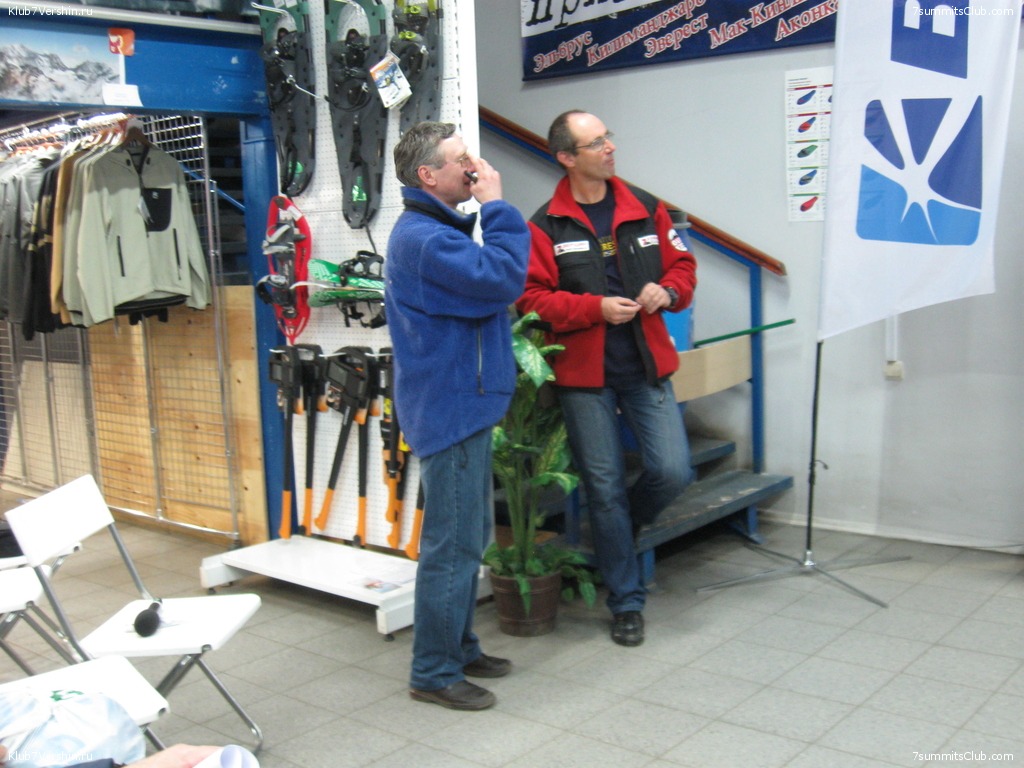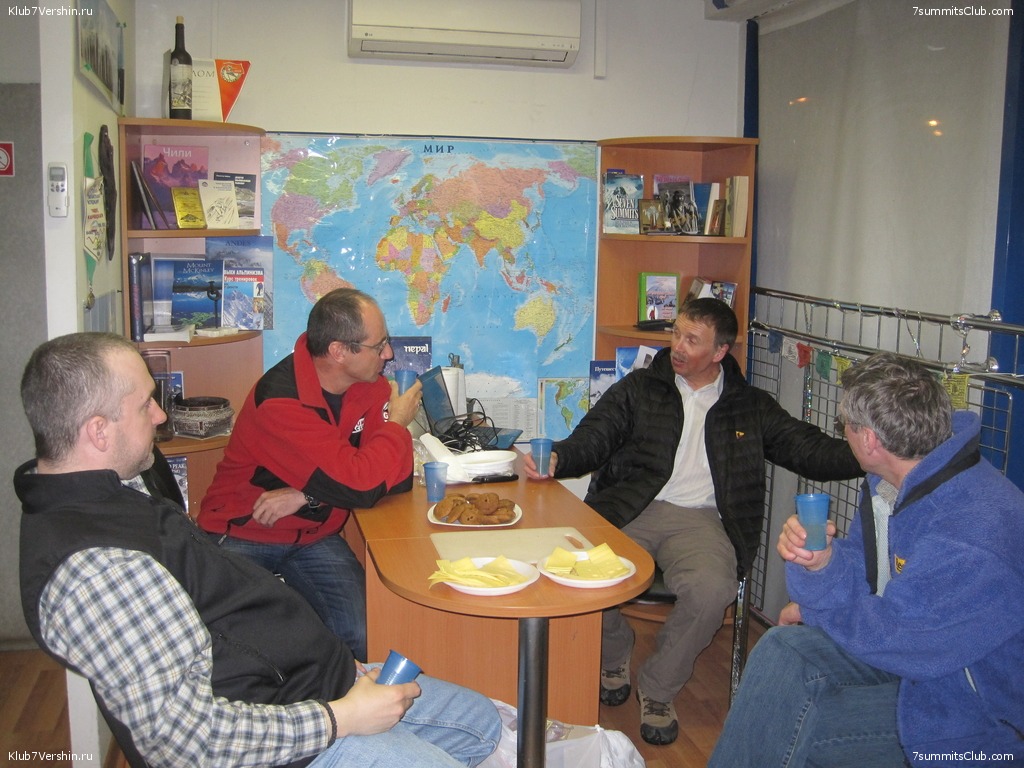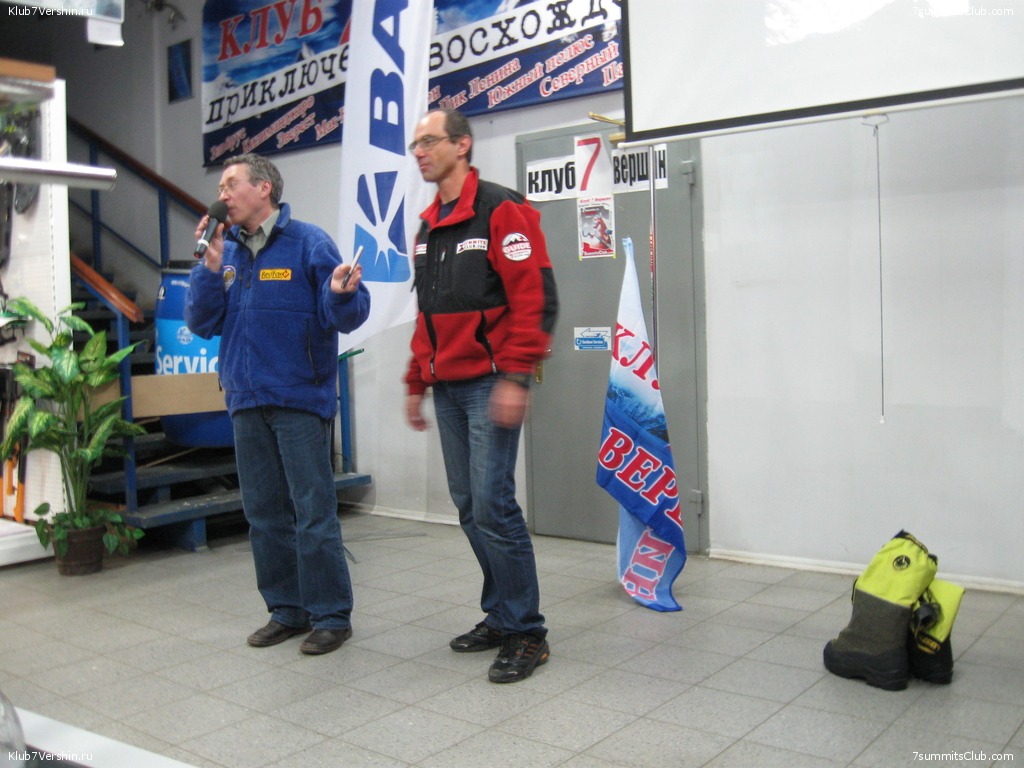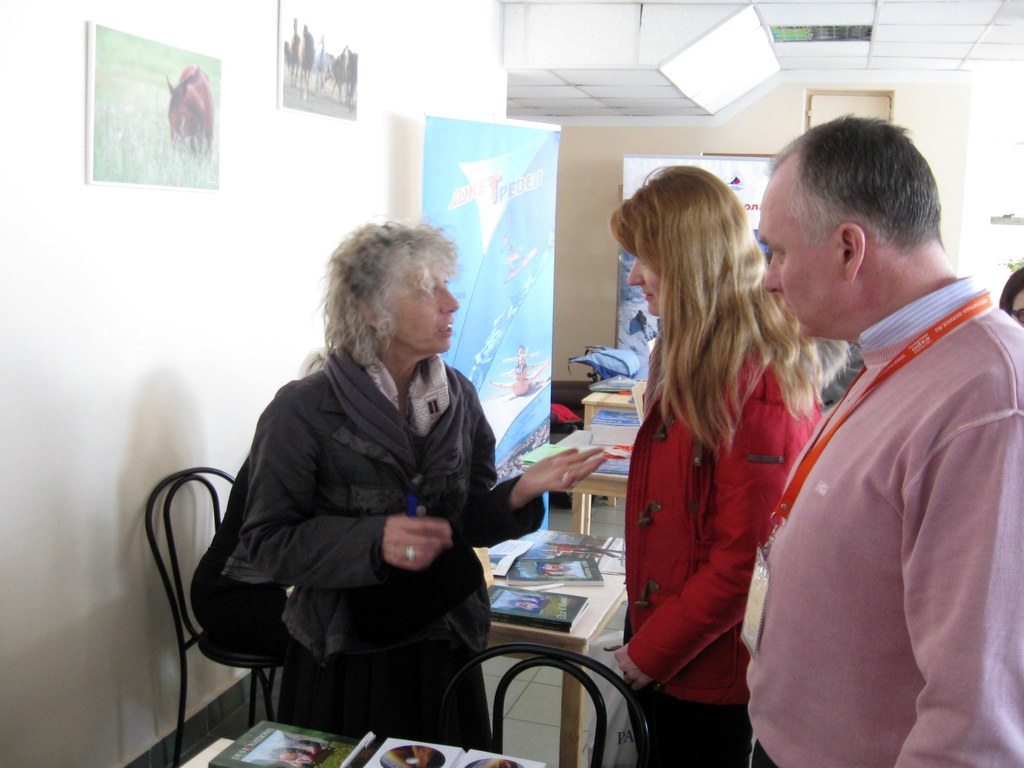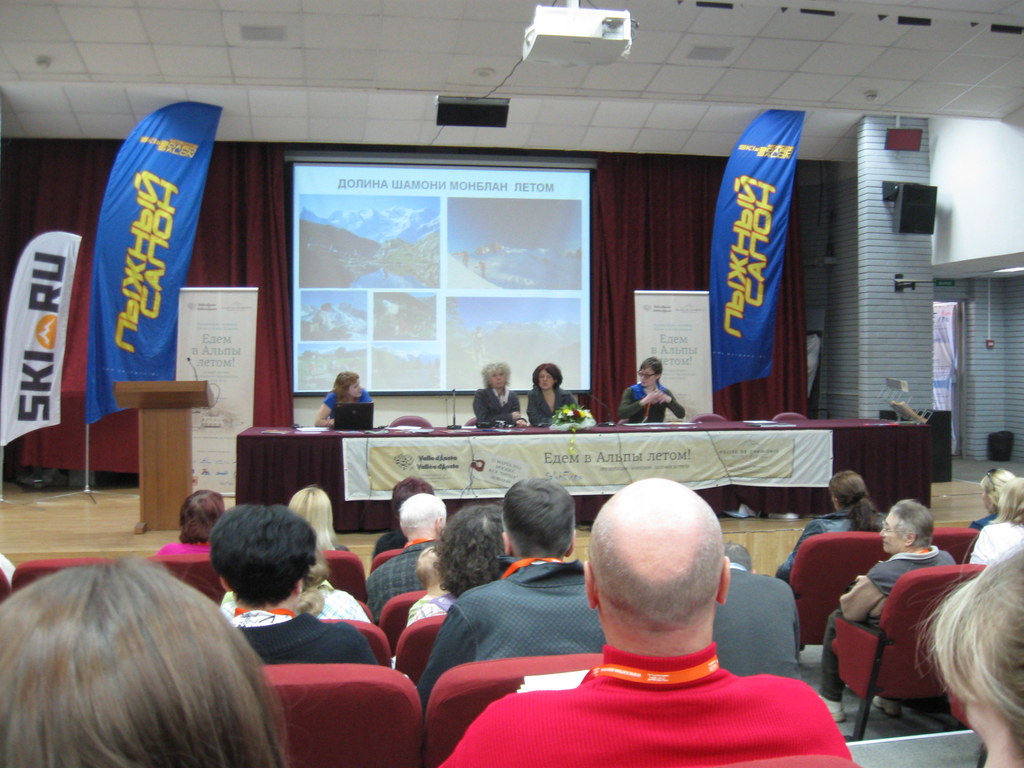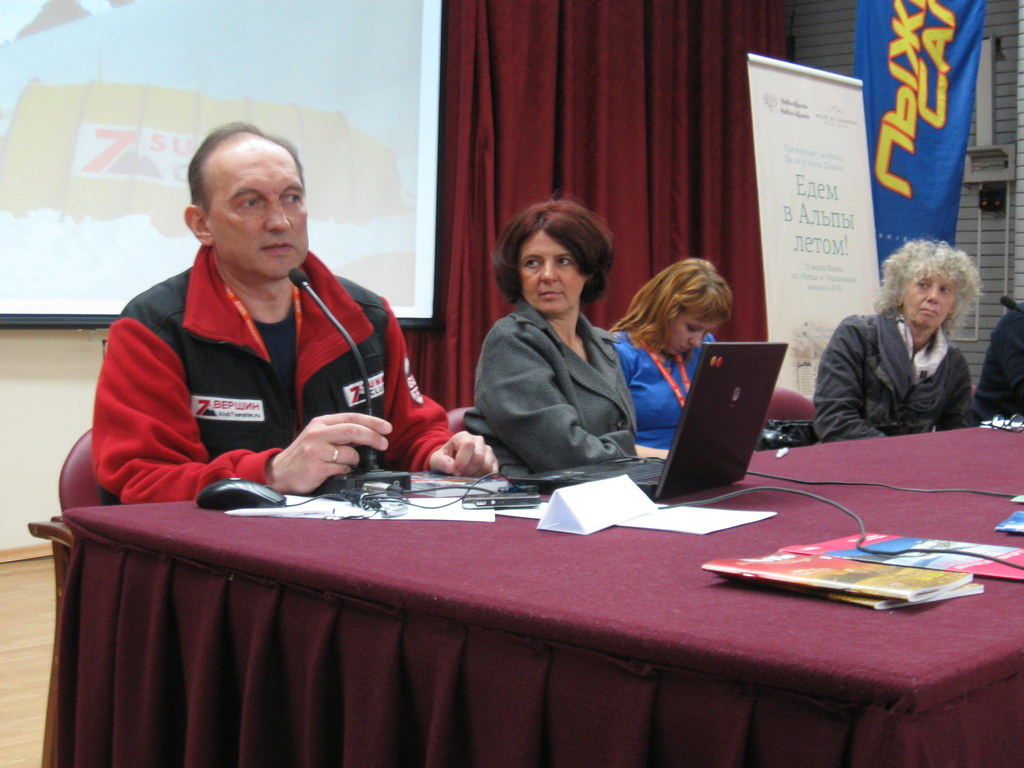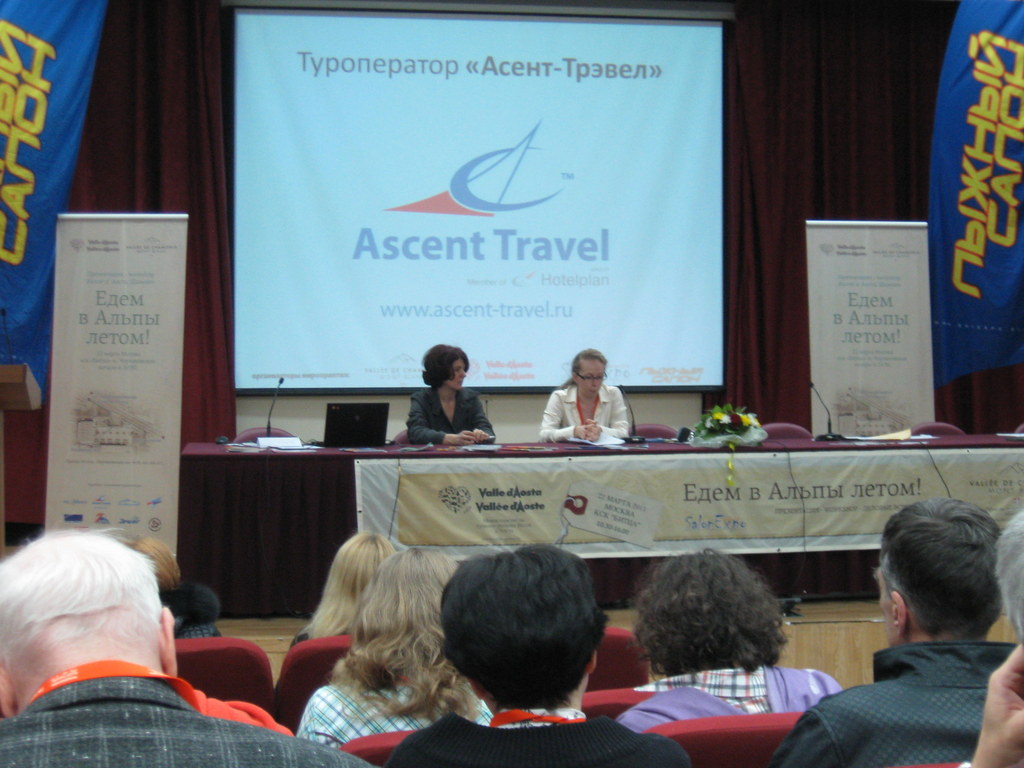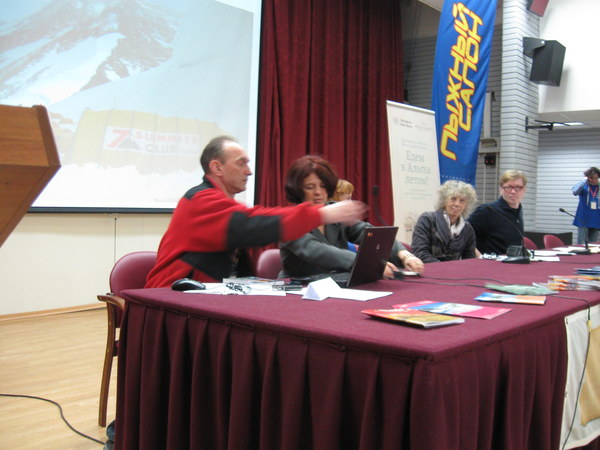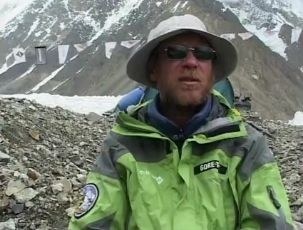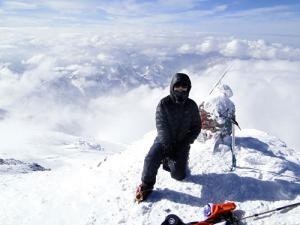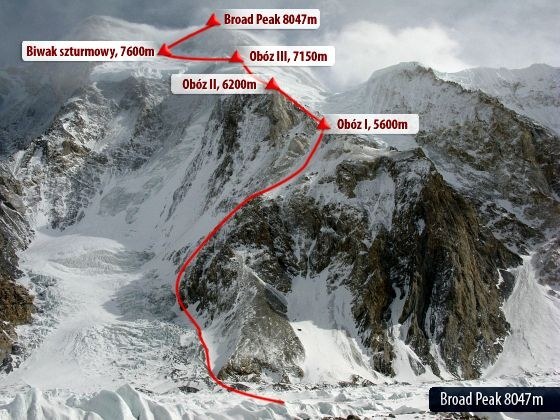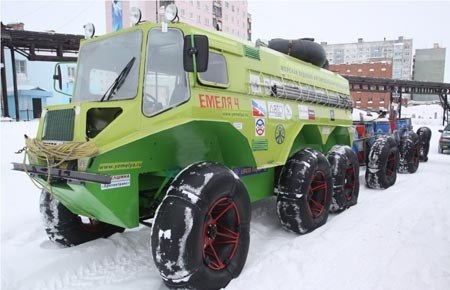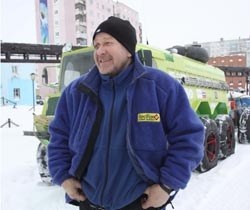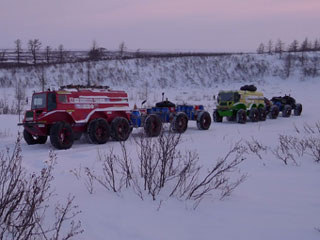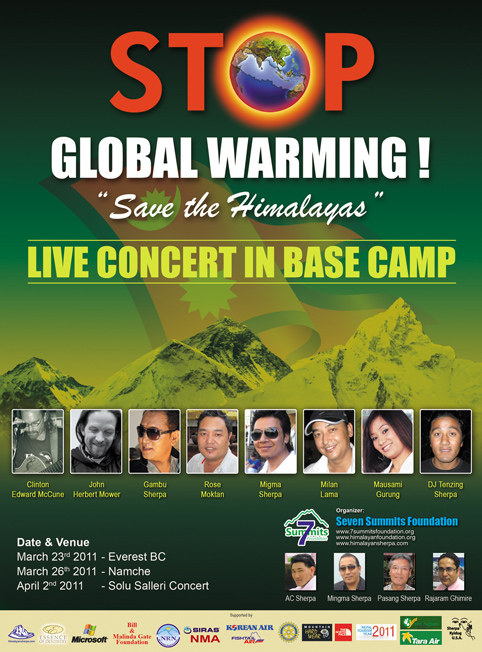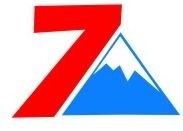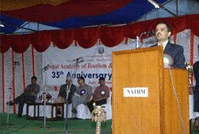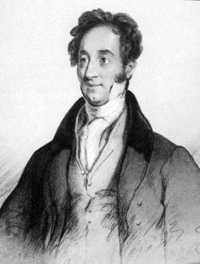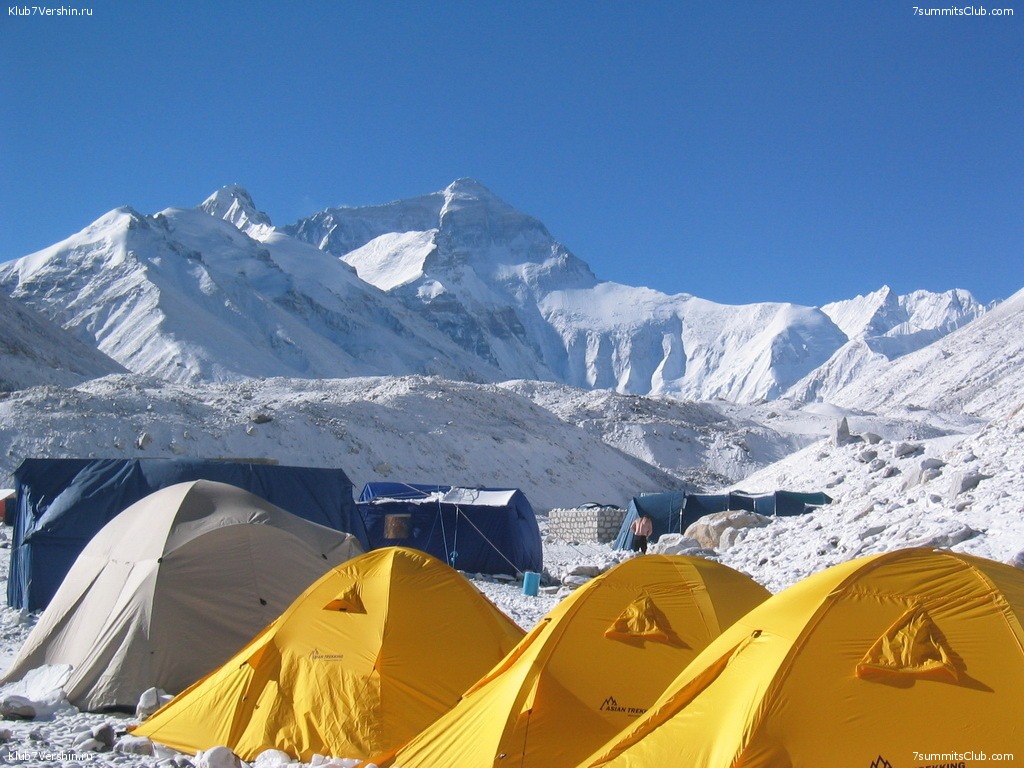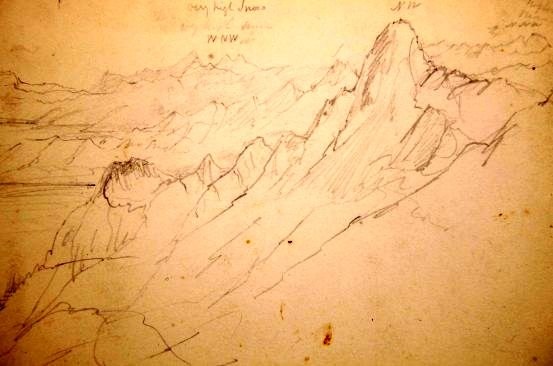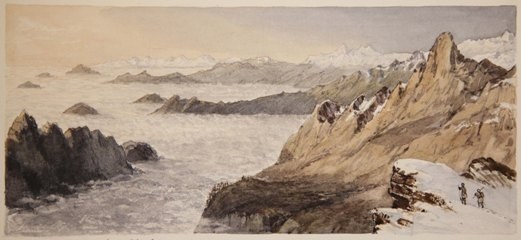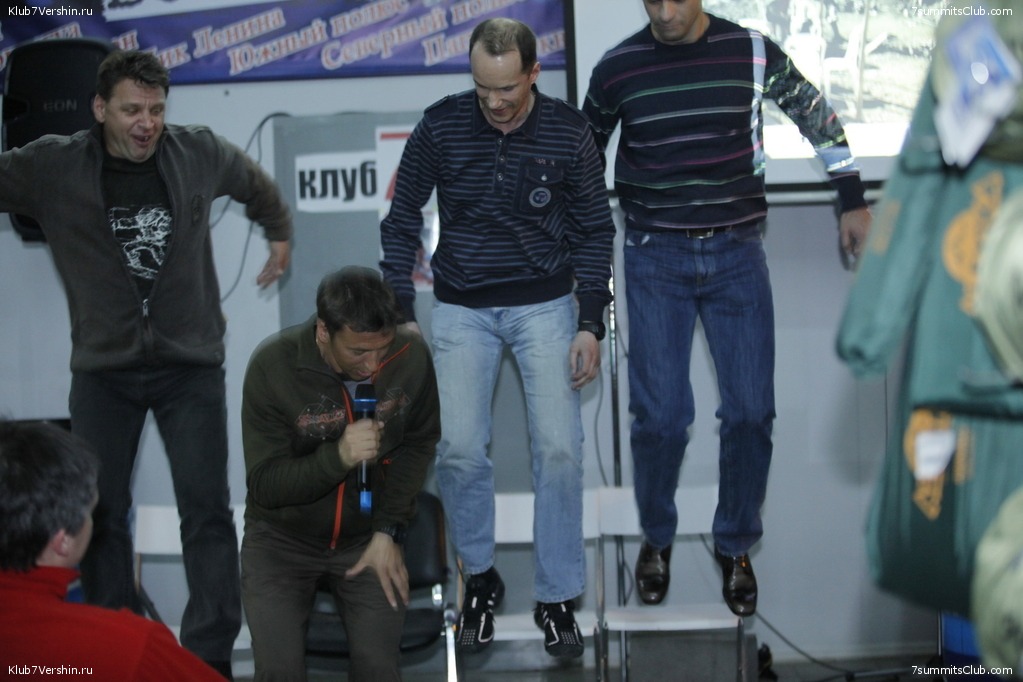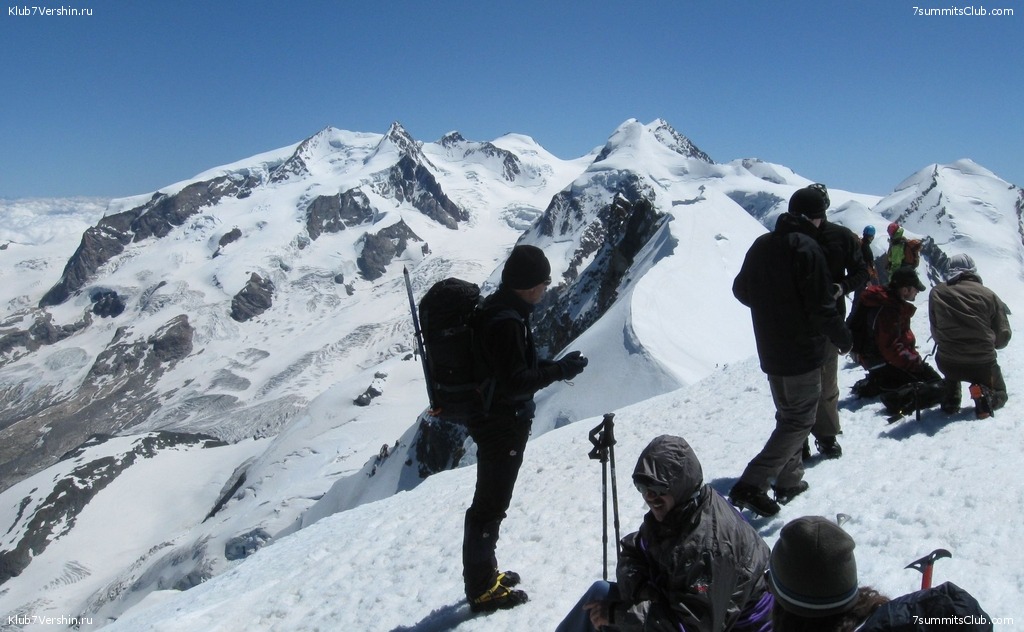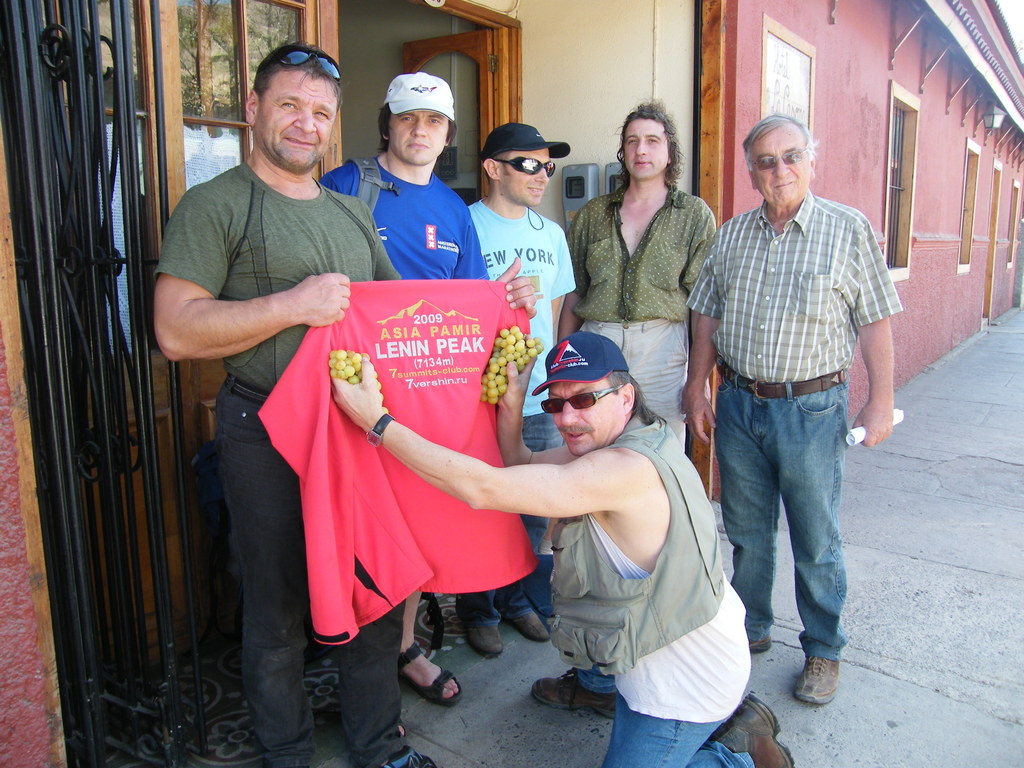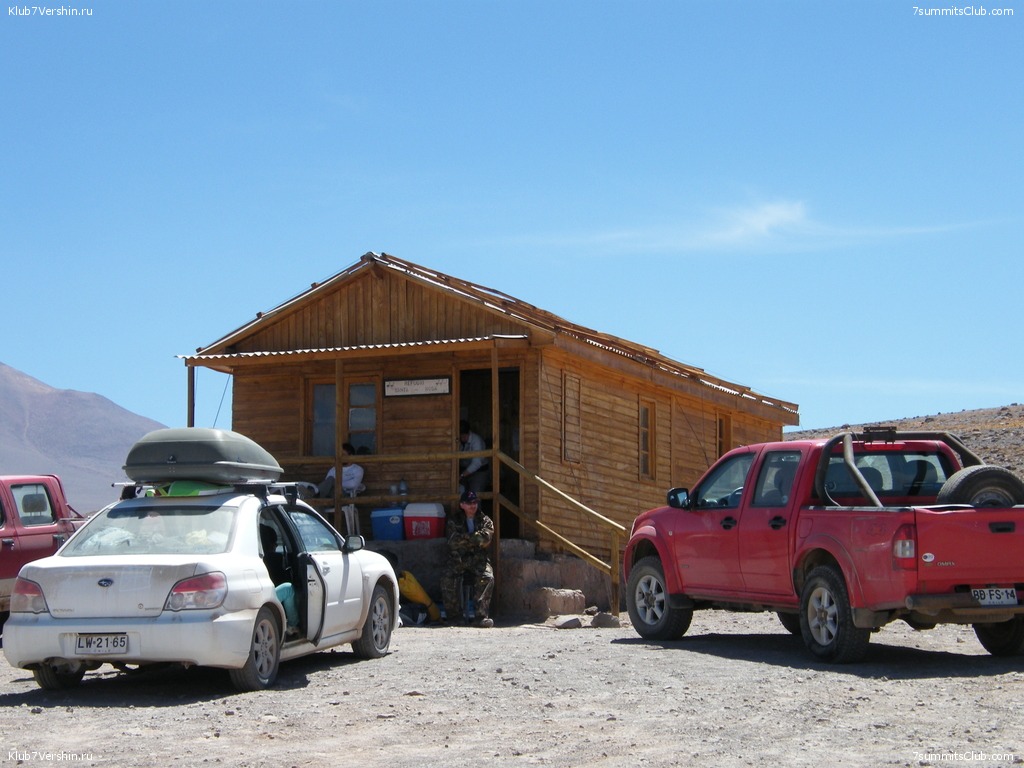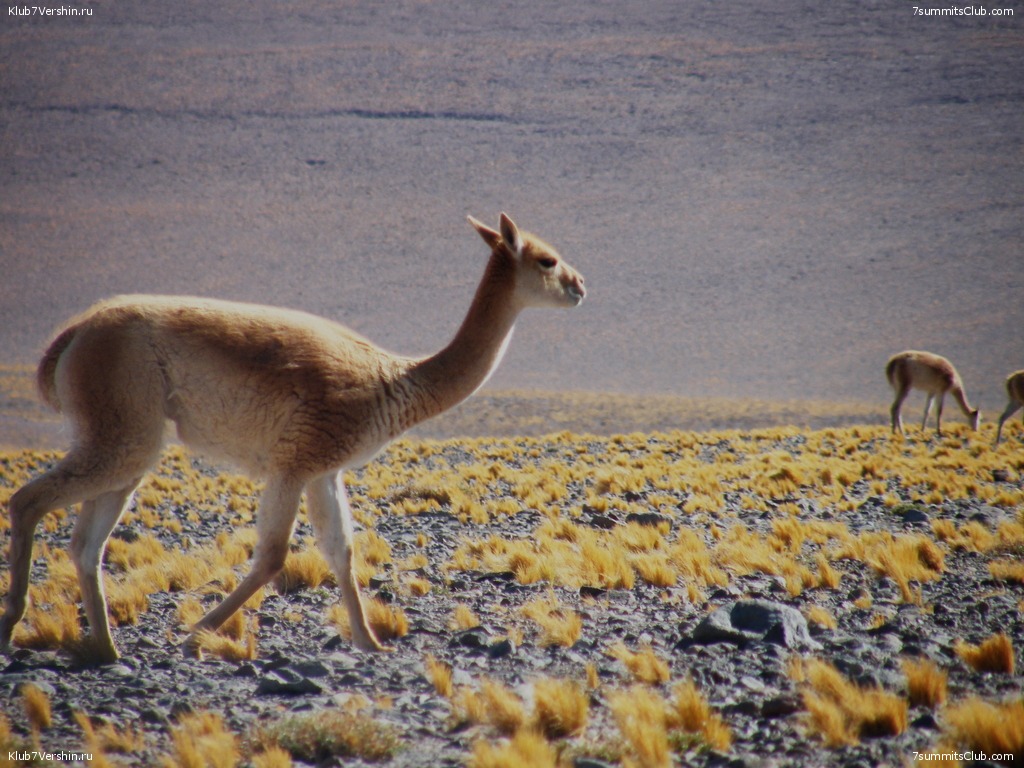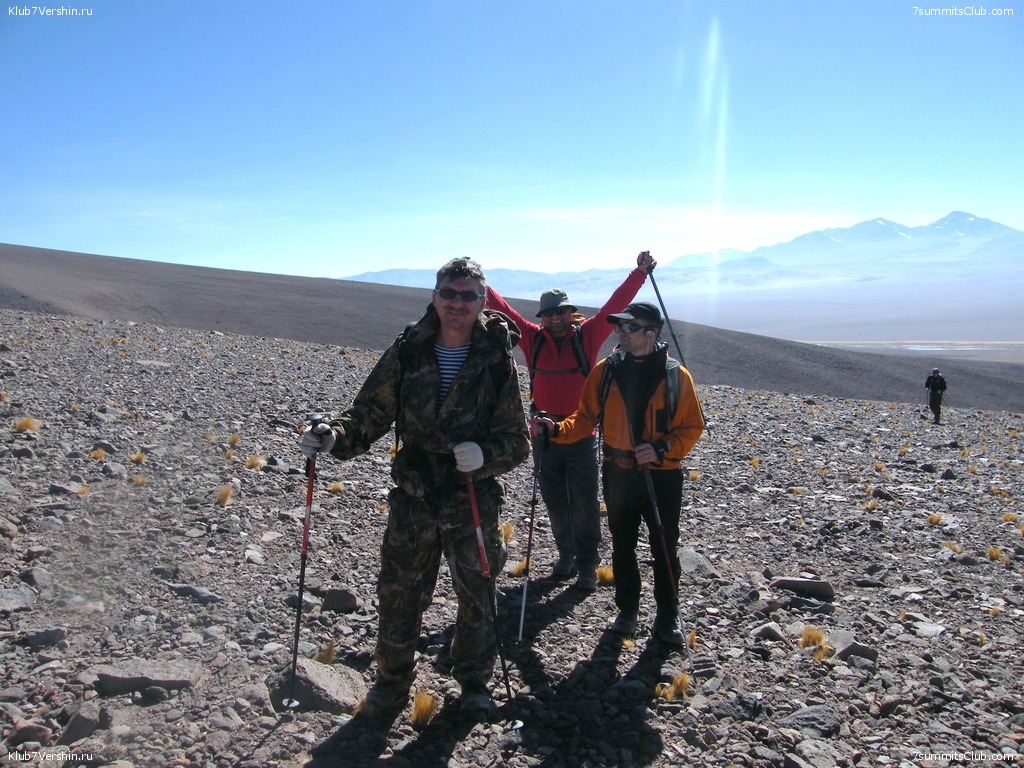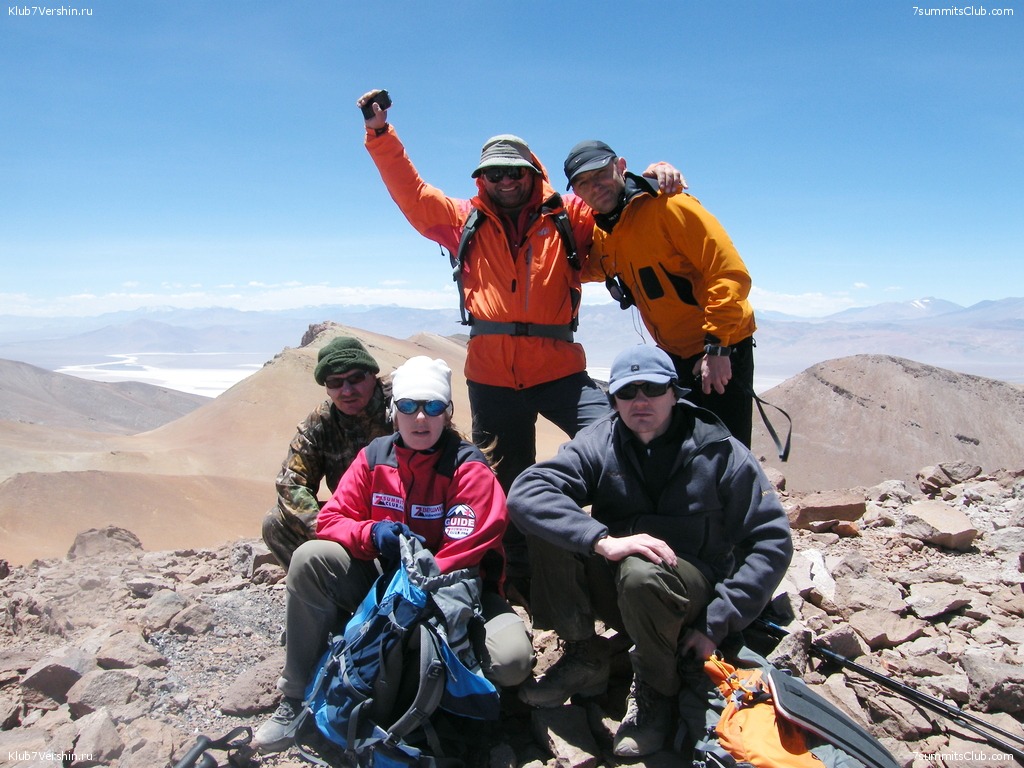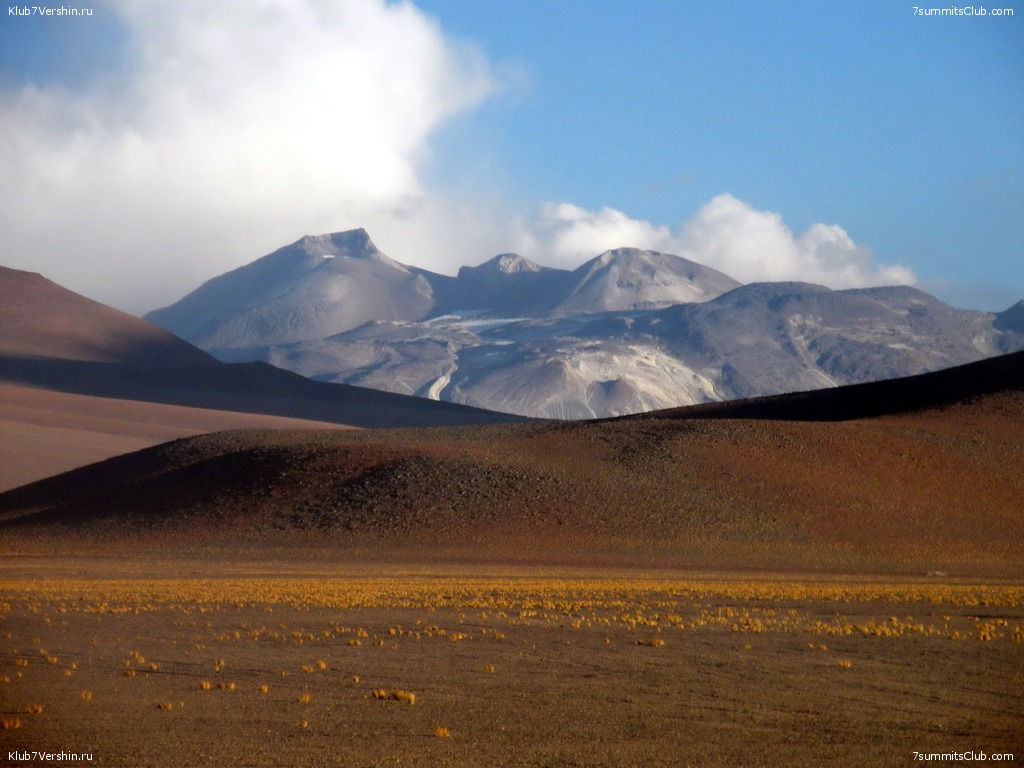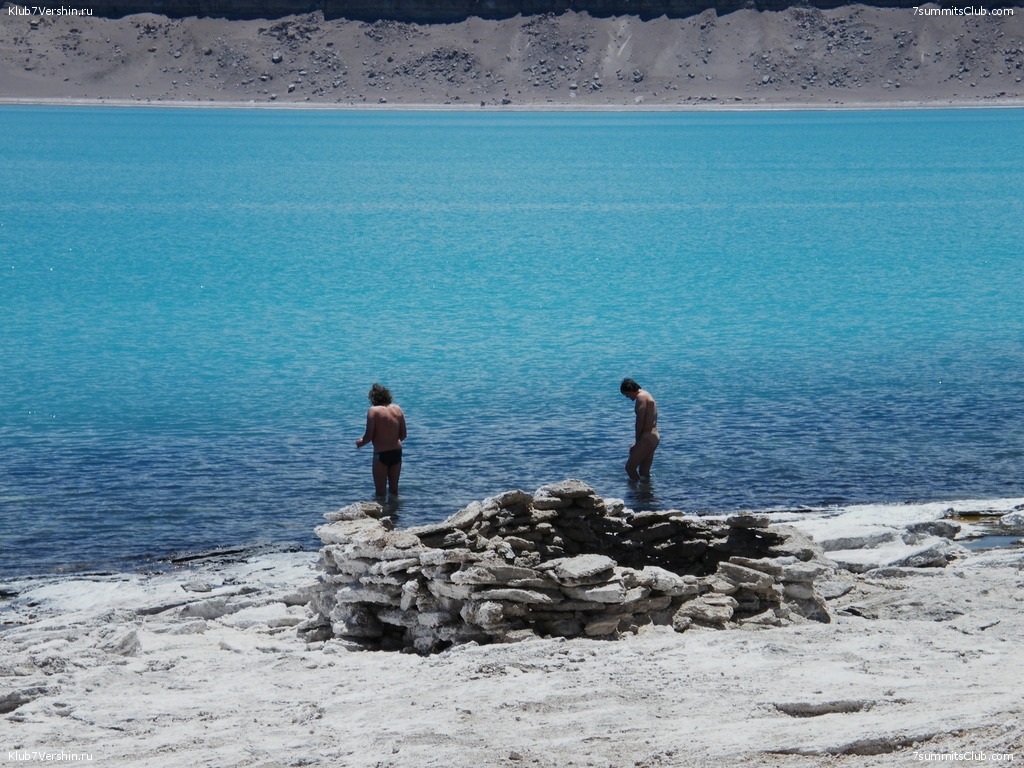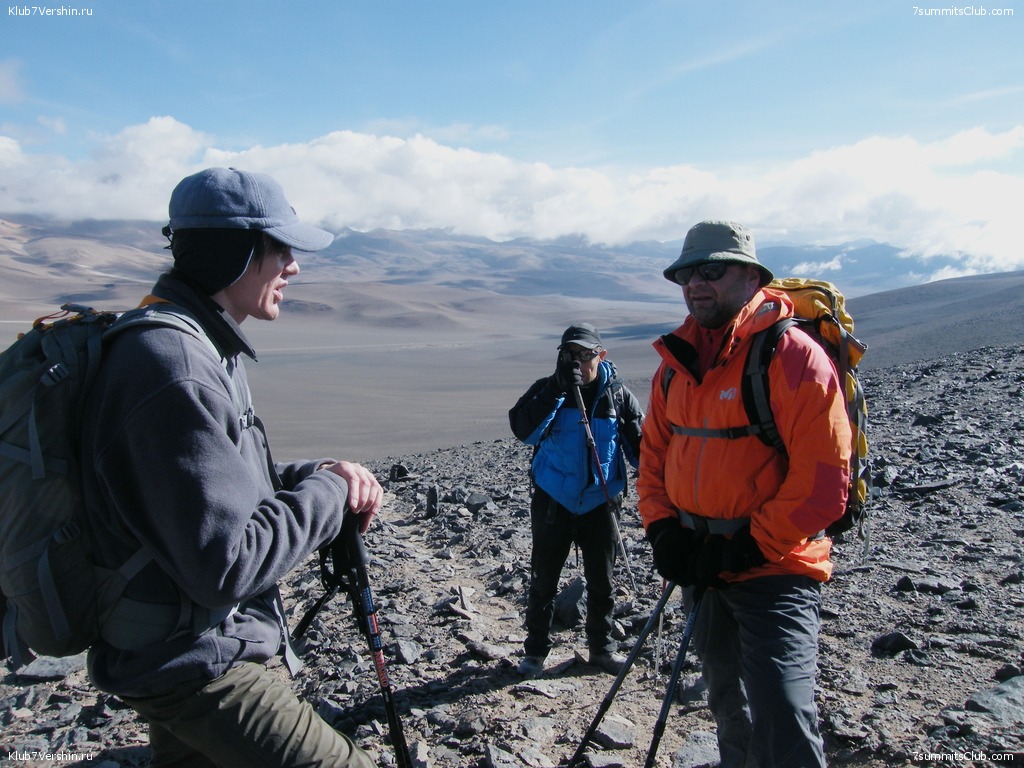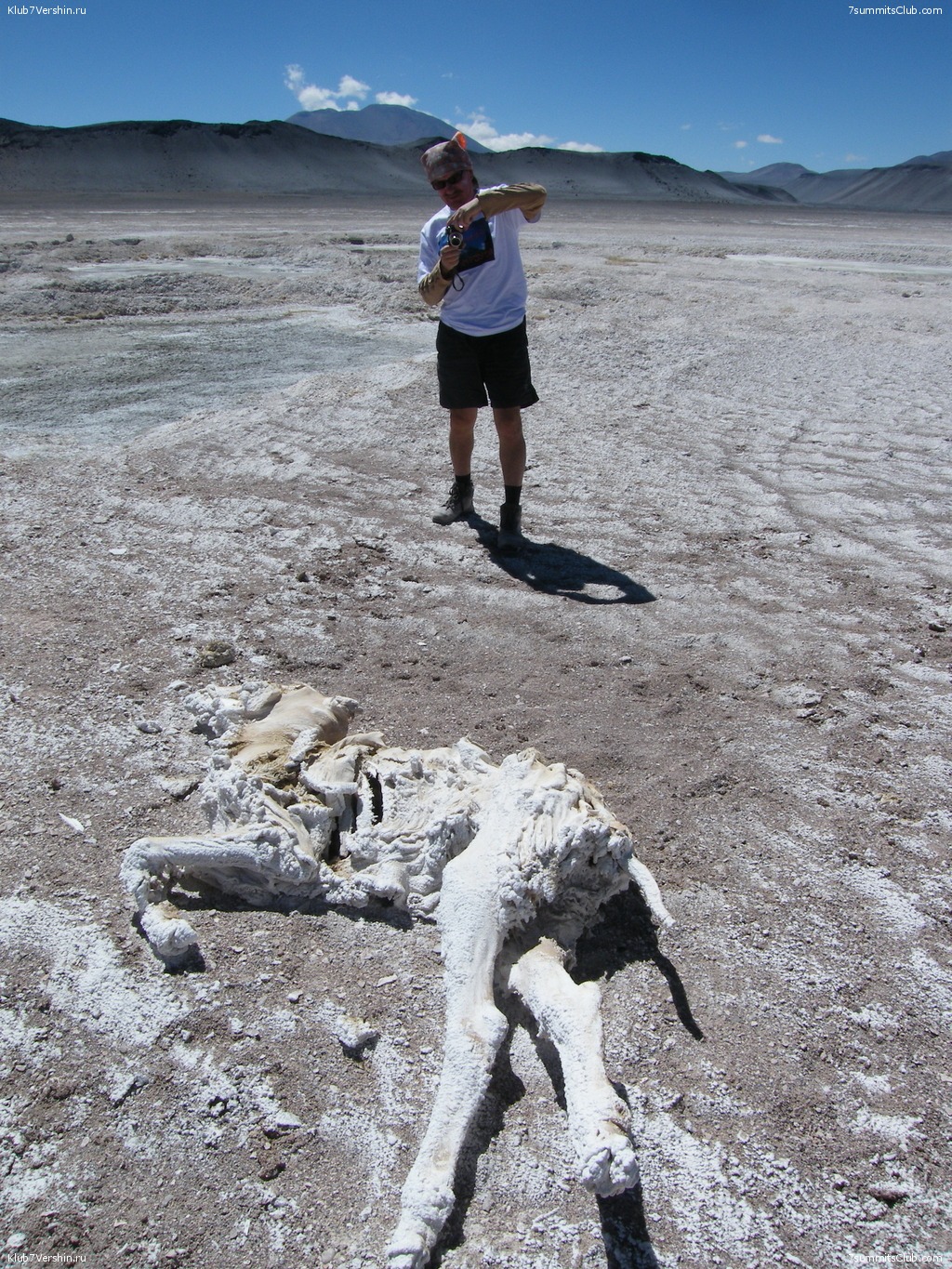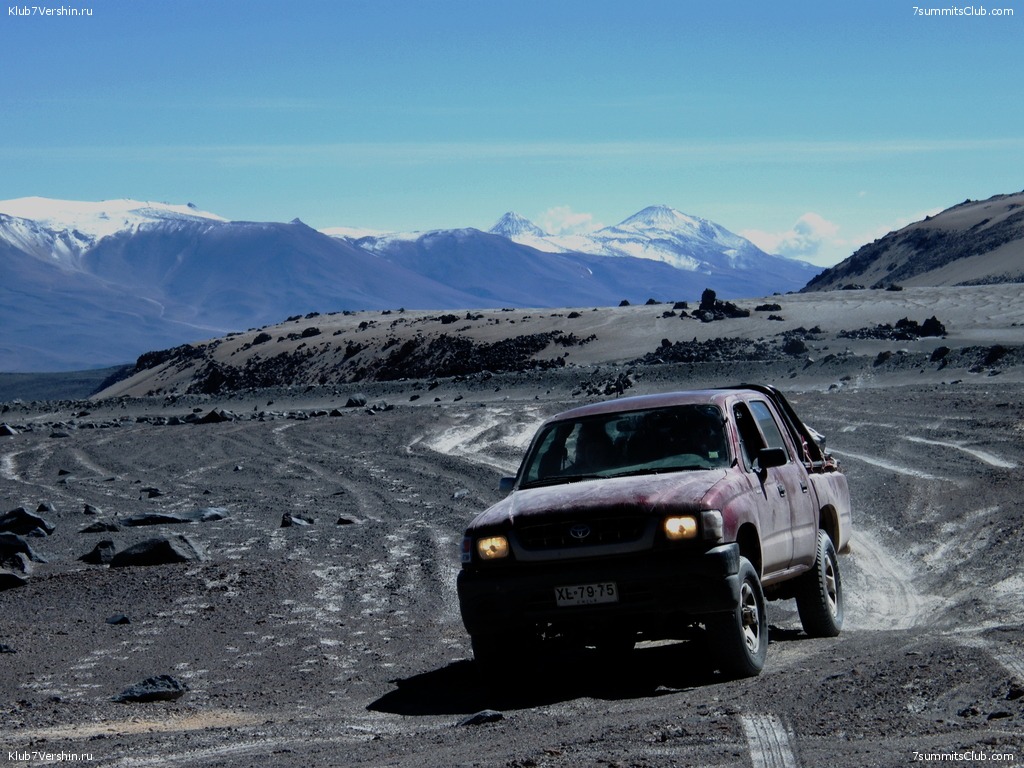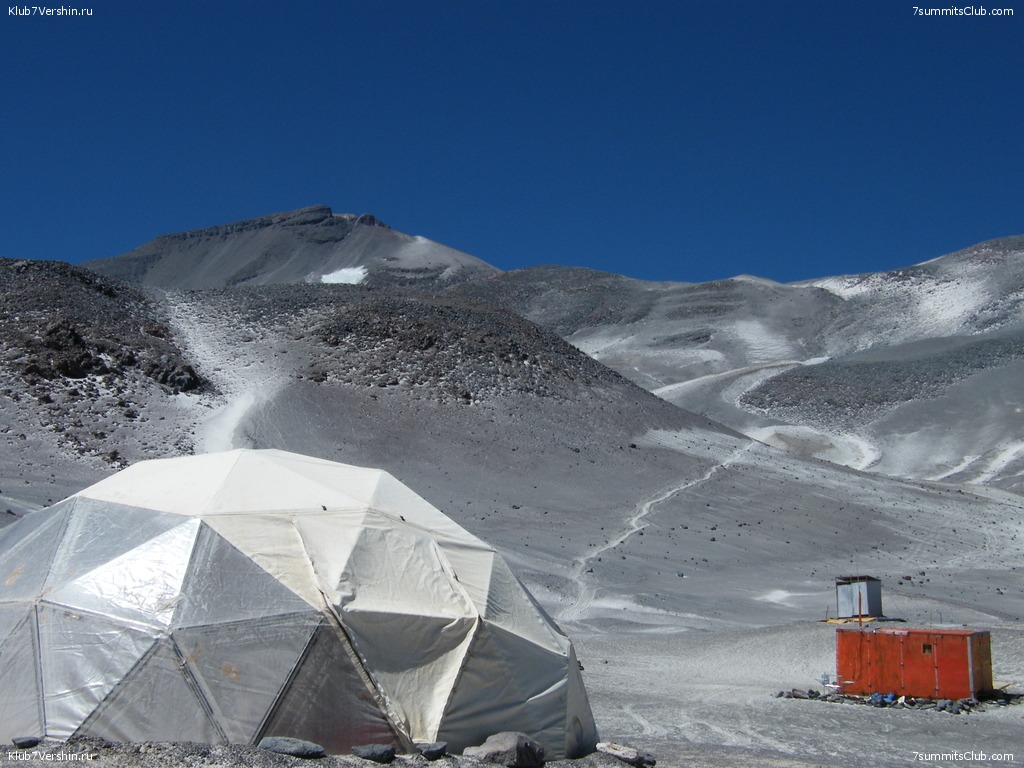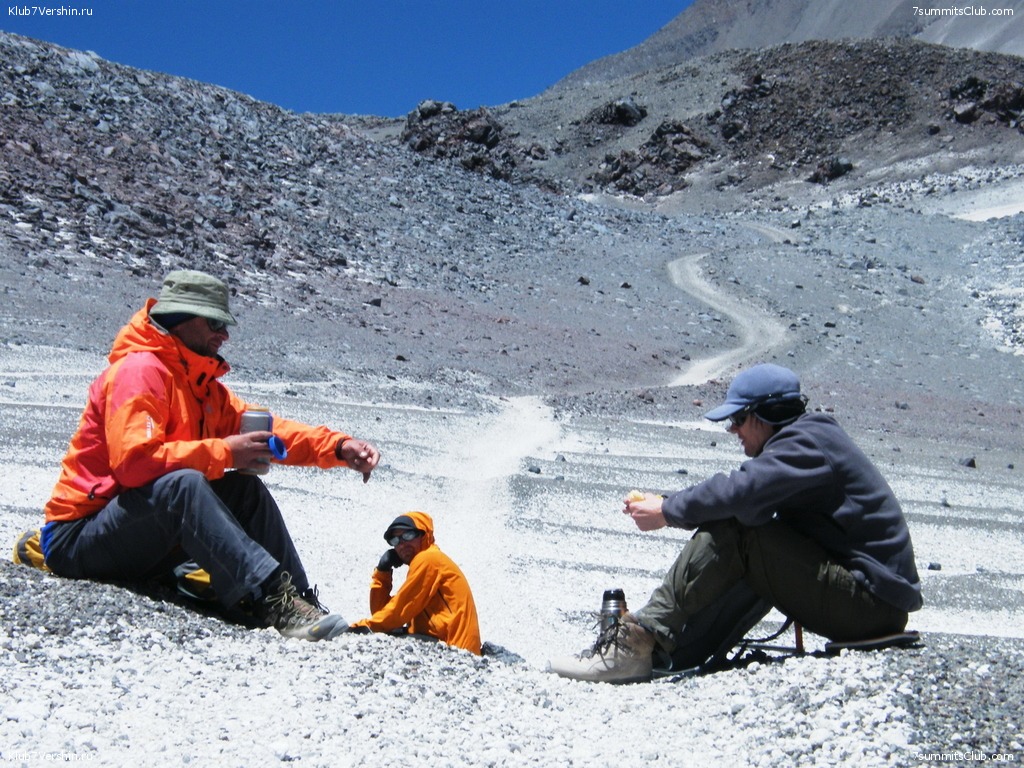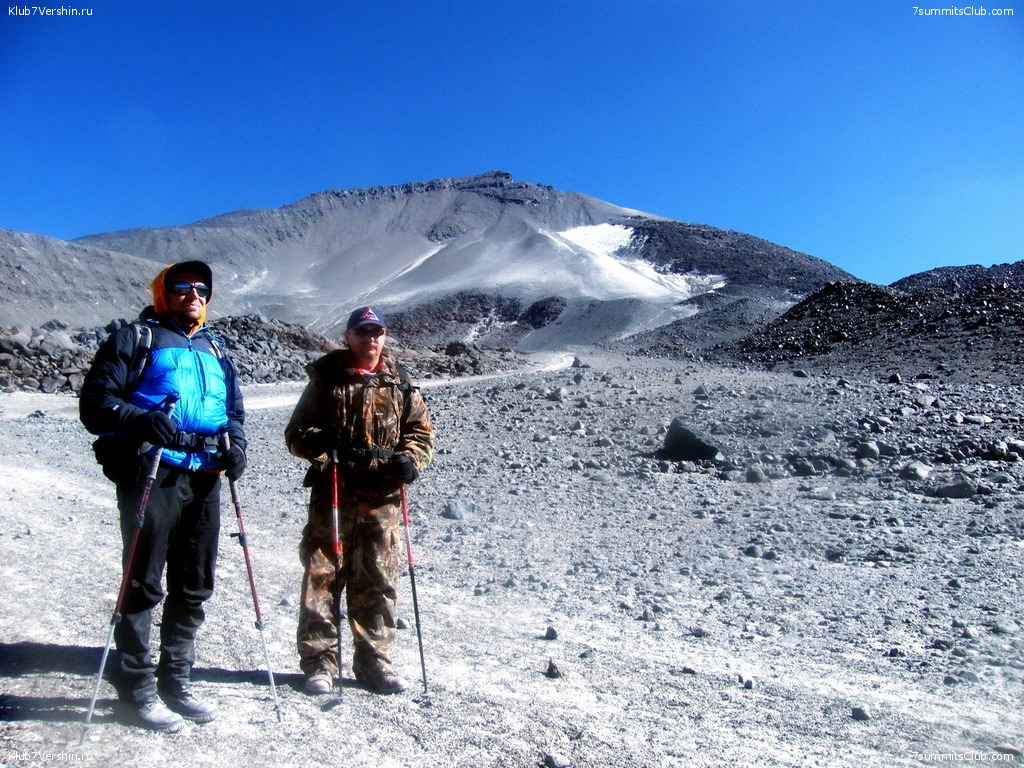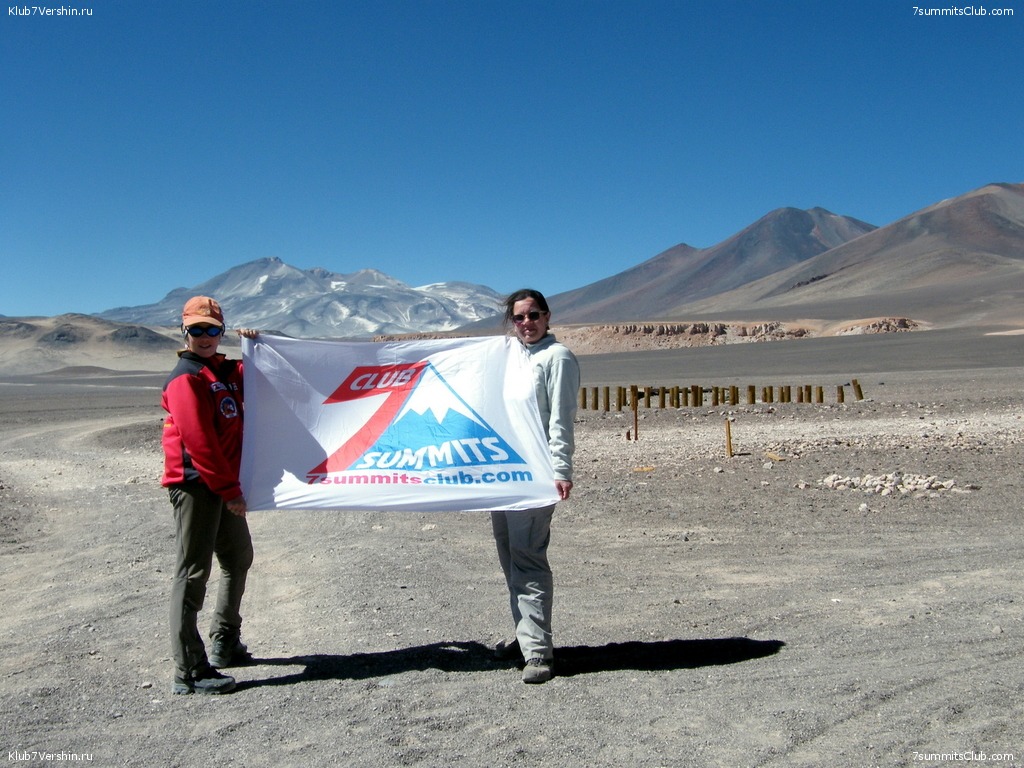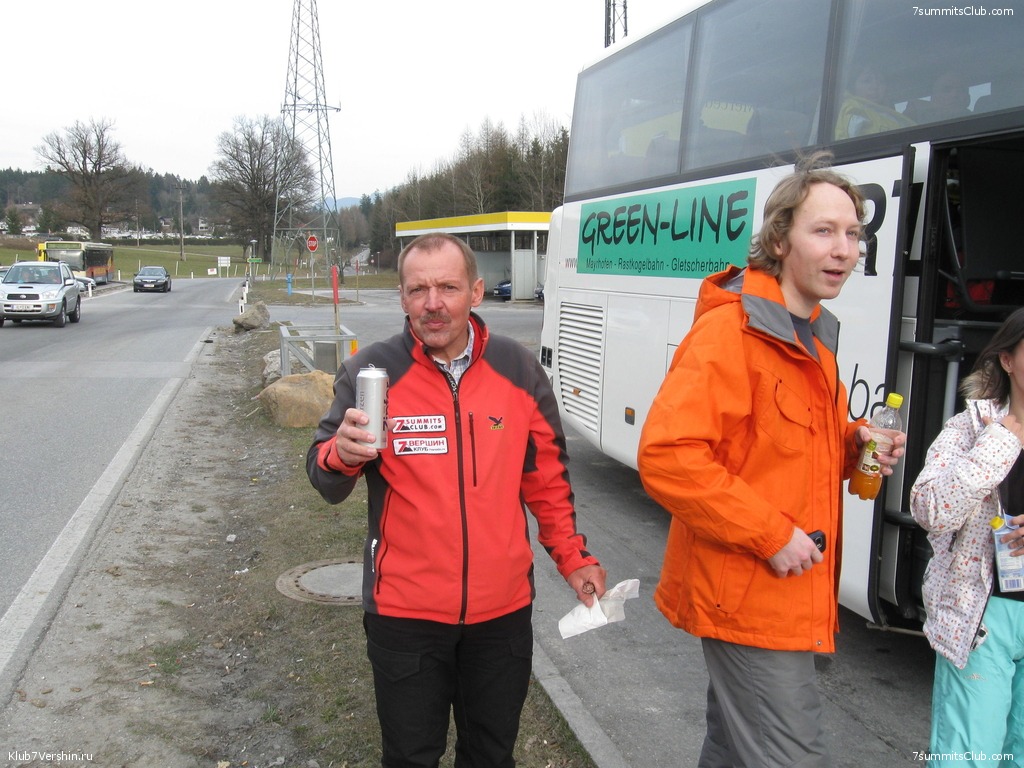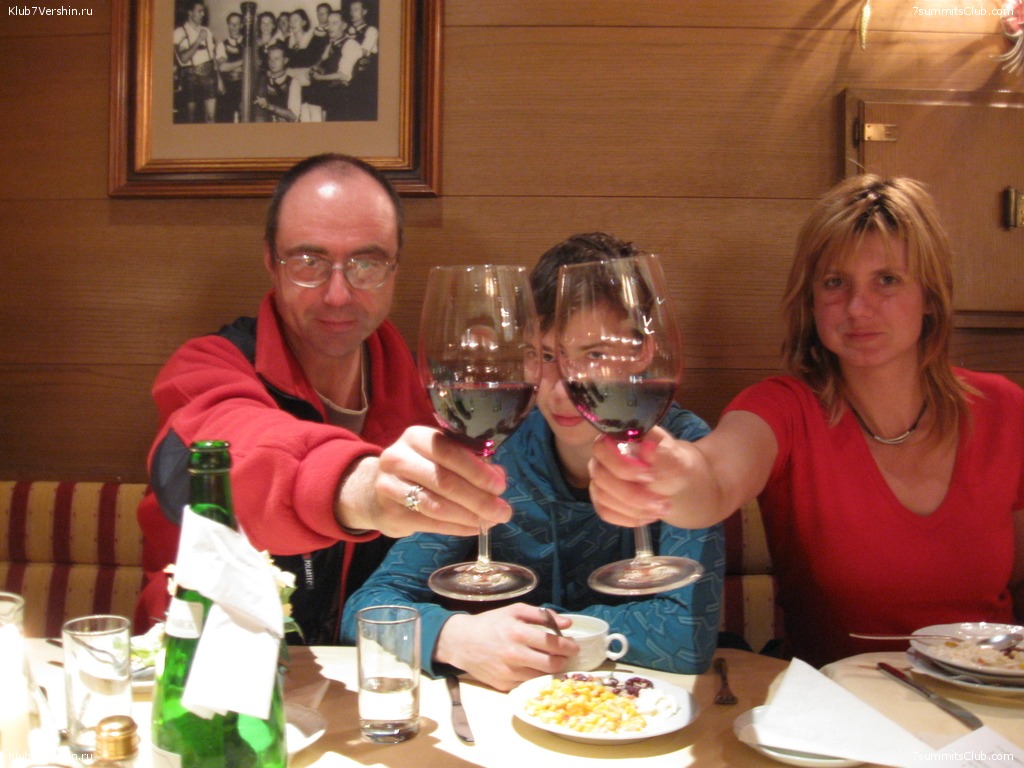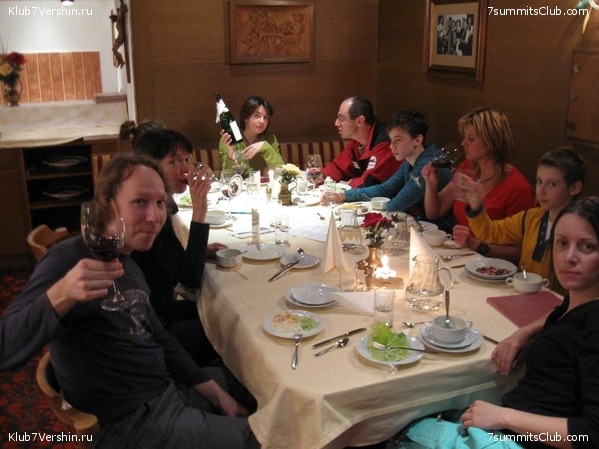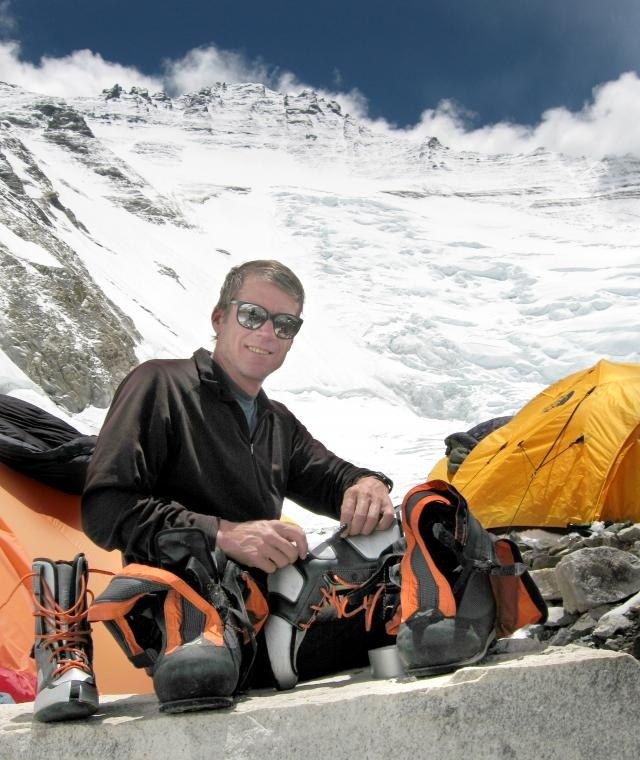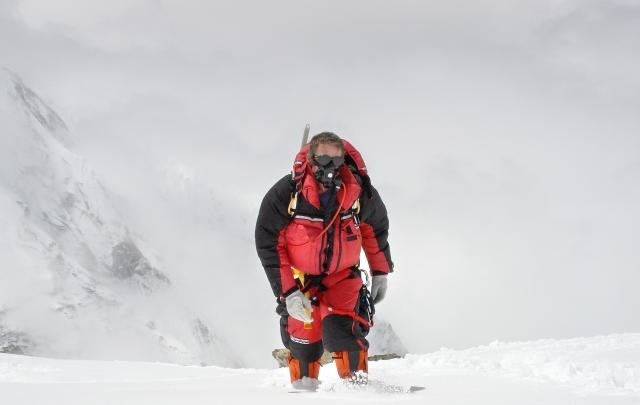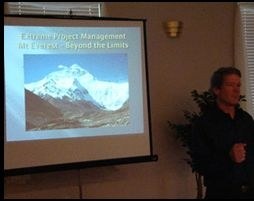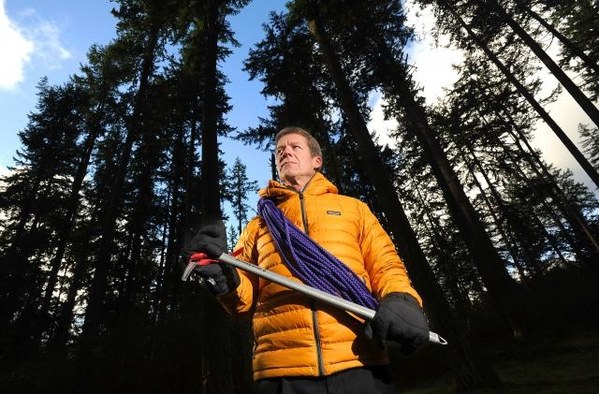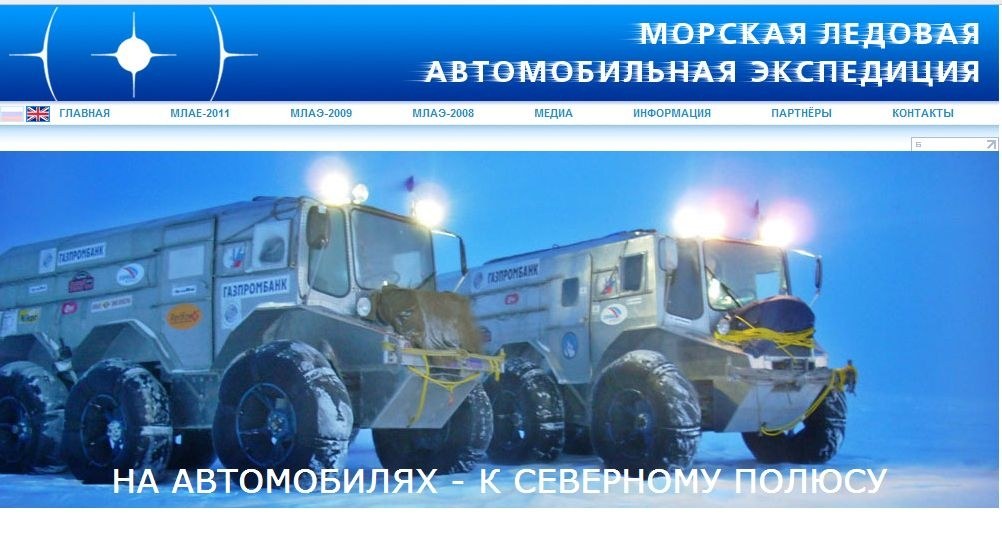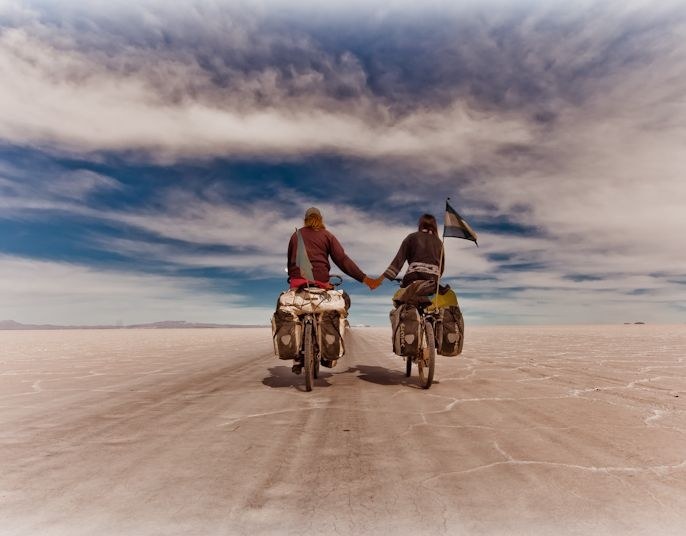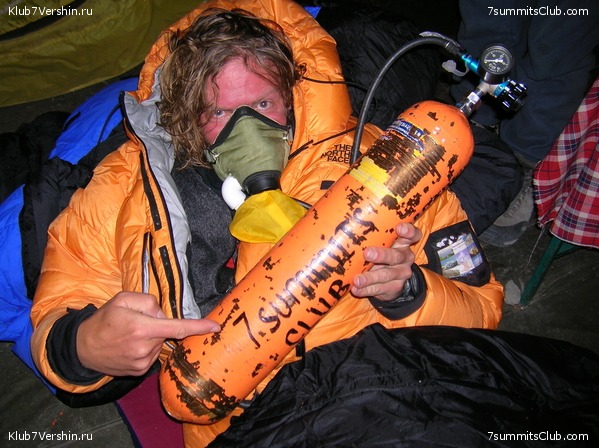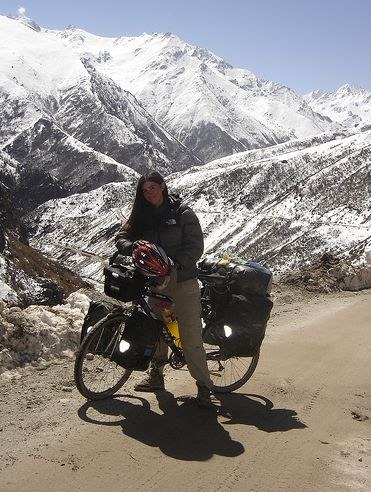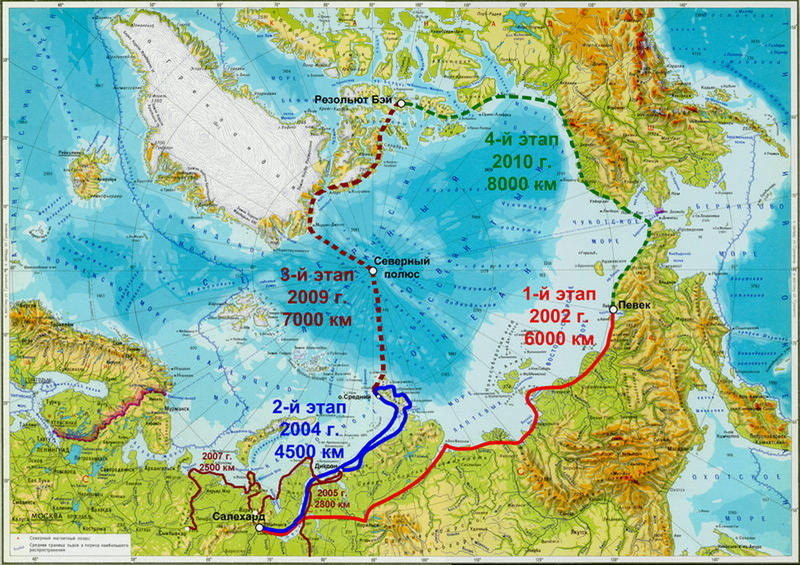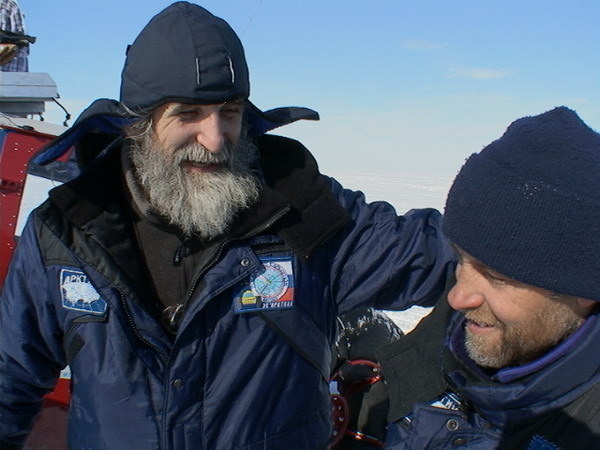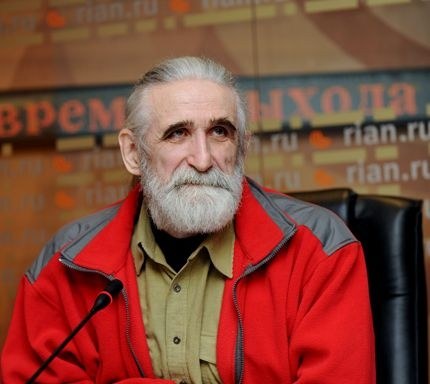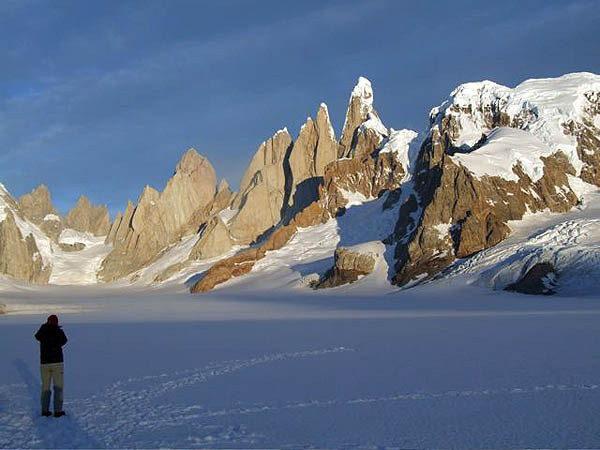All news: 2011
The Chronicles of transpolar expeditions
North Pole.
24 March 2011. Blizzard lasted for four days, warm - up to -7 C °, drifting snow, white-out, a strong wind. The Arctic has prepared for our verification of the entire set of its surprises. On low speed we move through with ...
24 March 2011. Blizzard lasted for four days, warm - up to -7 C °, drifting snow, white-out, a strong wind. The Arctic has prepared for our verification of the entire set of its surprises. On low speed we move through with clenched teeth, and pushing his views are more in the Navigator screen and the computer with the card than the windshield, get to the northern tip of Island Russky. Machines behave well, the team, too, going round the clock, and if the watch falls on the dark, it is considered good luck, as in the light of powerful lights landscape of snow and ice ridges are seen better than in the afternoon milk.
MLAE-2011 is short for Marine Live-ice Automobile Expedition 2011. It is organized under the patronage of Arthur Chilingarov – Special representative of President of Russian Federation for international cooperation in the Arctic and the Antarctic.
RCAE is short for Russian Center for Arctic Exploration – an Autonomous Non-profit Organisation which is developing innovative amphibious automobiles “YEMELYA” and organizing expeditions in High Arctic.
This year March 4, 2011 our team had started from town of Urengoy in Yamalo-Nenetskij Autonomous Region of Russia and is driving up to the North Pole (approximately until April 20) and further to Ward Hunt Island, Canada (supposingly by May 26) and will finish in the town of Resolute, Nunavut, Canada (probably by May 31) plus a few days spare. From Resolute Bay we shall fly to Montreal before we can fly home to Moscow.
For the expedition we shall use newly built automobiles “Yemelya-3” and “Yemelya-4”. We plan to leave them in Resolute Bay for a period of 10 months until March 2012 when we plan to return to Nunavut from Russia and continue the route of the expedition further on along the coastline of Canadian Arctic to Alaska.
During previous expedition MLAE-2009 – seven-men crew: Vasily Elagin Afanassi Makovnev, Vladimir Obihod, Sergey Larin, Alexey Shkrabkin, Alexey Ushakov, Nikolai Nikulshin in two automobiles “Yemelya-1” and “Yemelya-2” under the leadership of Vasily Elagin had started from Severnaya Zemlya, Russia and after 38 days and 2033 km of driving over drift ice for the first time in history of Arctic exploration reached the North Pole by car. It happened on April 26, 2009 and now this achievement is included into Russian Book of Records.
Sumo wrestler Kelly Gneiting finishes LA marathon and plan to climb Everest
Everest.
Gneiting, shown during a 2004 competition, beat his previous time by two hours A 400lb American sumo wrestler hopes to become certified as the heaviest man to finish a marathon after competing the Los Angeles race in nearly 10 hours. ...
Gneiting, shown during a 2004 competition, beat his previous time by two hours
A 400lb American sumo wrestler hopes to become certified as the heaviest man to finish a marathon after competing the Los Angeles race in nearly 10 hours.
Kelly Gneiting, who was the last of 11,891 men to cross the Los Angeles marathon finish line on Sunday, described the race as "pure hell".
Gneiting walked the last 18 miles, suffering through painful blisters, but beat his 2008 time by two hours.
He has won three US sumo titles beginning in 2005.
"I did it, but it was hell," Gneiting, 40, was quoted as saying by the Los Angeles Times. "Pure hell."
Gneiting of Arizona weighed in after the race at 396lb (179.6 kilos) - four less than when he started, local television reported.
By the time Gneiting finished the first half, the city had begun reopening streets along the route and he completed the race on the pavement, NBC television reported.
Gneiting hopes to have his time - nine hours and 48 minutes - certified by the Guinness Book of World Records.
Barneo 2011 press conference
North Pole.
On 21 March, a press conference was held to present the high-latitude Arctic expedition Barneo 2011; the two venues, in Moscow and St. Petersburg, were linked by a multimedia “video bridge”. This year Barneo 2011 is sponsored by ...
On 21 March, a press conference was held to present the high-latitude Arctic expedition Barneo 2011; the two venues, in Moscow and St. Petersburg, were linked by a multimedia “video bridge”.
This year Barneo 2011 is sponsored by the Russian Geographical Society. Since 2002, the Barneo ice camp ensures Russian presence in the North Pole region. The base is maintained by Polius Expeditionary Centre of the Russian Association of Polar Explorers.
The press conference participants in Moscow included Artur Chilingarov, Russian President’s special representative for international cooperation in the Arctic and Antarctica and the First Vice-President of the Russian Geographical Society; Alexander Orlov, Head of Barneo 2011 expedition and Vice-President of the Russian Association of Polar Explorers; and Dmitri Shparo, leader of “Skiing to the North Pole!” youth expedition.
In St. Petersburg the press conference was attended by Victor Boyarsky, Director of the Arctic and Antarctic Museum; Vladimir Strugatsky, Vice-President of the Russian Association of Polar Explorers; and Viacheslav Makeyev, Head of Nature Management Department at the State Polar Academy.
Currently the expedition is getting ready for the logistics stage. Building on the Soviet polar explorers’ experience and using their own innovative approaches and designs, Polius Expeditionary Centre plans to set up the Barneo ice camp in the early April. Barneo base will work for a month, performing various operations. In 2011 the camp expects to receive more than 300 tourists who’ll have a chance to reach the North Pole.
Two research teams will be working at the station. Members of the Arctic and Antarctic Research Institute will work according to their research programmes on a drifting ice floe. The PanArctic Ice Camp Expedition (PAICEX) of the Shirshov Institute of Oceanology of the Russian Academy of Science will carry on for the fifth year running. And for the fourth year in a row, youth skiing expedition will go to the North Pole, led by Matvey Shparo and Boris Smolin.
http://int.rgo.ru/news/barneo-2011-press-conference/
Photographs by Yaroslav Nikitin and Darya Shlykova
Evening Party of The 7 Summits Club - a pity that it is so seldom
When one place is meeting many friends, there is a peculiar aura, there is something special sense of unity. And the sense of the meaning of what we do. Of course, this may not happen often. But I would like it to be at least four times a ...
When one place is meeting many friends, there is a peculiar aura, there is something special sense of unity. And the sense of the meaning of what we do. Of course, this may not happen often. But I would like it to be at least four times a year. The evening party began with a demonstration of the film, whose name can be taken as an epigraph for the whole of our work. "We are living rightful." As later said Victor Bobok, "at the plain we're just getting ready for real life, which is up there. In the mountains." We see on the screen Pavel Shabalin with his little daughter Masha. We see Alexander Abramov on the North Face of Aksu Peak ....
7 Summits Club was represented at the exhibition "Go to the Alps in the summer!"
Workshop "Go to the Alps in the summer!" held March 22 at KSC Bitza. It was devoted to summer holidays in the Alps. Organizers - company Skiexpo, at the request of tourism departments of Chamonix and Aosta Valley. Representatives of these ...
Workshop "Go to the Alps in the summer!" held March 22 at KSC Bitza. It was devoted to summer holidays in the Alps. Organizers - company Skiexpo, at the request of tourism departments of Chamonix and Aosta Valley. Representatives of these regions Agnes Ducroz and Anna Sodin, well speaking in Russian, set the tone throughout the work. Their joint appearance lasted more than an hour. Because such statements they made not the first time, they talked fluently and good. From time to time, their narrative speech was interrupted by a very appropriate emotional digressions. The hall has gathered some 100 people, there were at the same time representatives of the tourism business, media and just guests…
Pavel Shabalin - the main guest in the evening party of 7 Summits Club!
Everest.
Pavel Shabalin, one of the best climbers of the world, "Father of Ice climbing sports” and motor of sports ideas in the Mountaineering Federation of Russia. Pavel - our old friend and we are always happy to see him... Finally, we all ...
Pavel Shabalin, one of the best climbers of the world, "Father of Ice climbing sports” and motor of sports ideas in the Mountaineering Federation of Russia. Pavel - our old friend and we are always happy to see him...
Finally, we all come together. Importantly, our president and leader Alexander Abramov will be available for a few days before departure to Nepal and Tibet. “National climber of Russia” Viktor Bobok will be also, it is difficult to catch him in Moscow. Straight from the event, he will go again to his beloved Africa, at his beloved Mount Kilimanjaro. In addition, we prepare as a surprise, a few interesting guests. And so, in the program: appetizer buffet, exclusive drinks ... and reports, among which are the loudest: climbing the highest volcano in Antarctica Mount Sidley (Abramov), through the jungle to the top of Carstensz (Luda Korobeshko), on the glaciers of Patagonia (Luba Ivanova), violent season on Aconcagua (Bobok) .... The plans, of course, as usual, a raffle,,,, and informal part, meeting with close friends ...
In short, the event that can not be missed!
Word from Elbrus: Summits, Skiing, and Skydives (Explorersweb)
Elbrus.
Explorersweb about Elbrus. A plane jack last year involving climbers, a bomb destroying a Gondola lift and three skiers shot dead - Mount Elbrus was recently reportedly closed. Word arrived from Malli Mastan Babu (featured in Exweb for ...
Explorersweb about Elbrus. A plane jack last year involving climbers, a bomb destroying a Gondola lift and three skiers shot dead - Mount Elbrus was recently reportedly closed.
Word arrived from Malli Mastan Babu (featured in Exweb for achieving Fastest 7 summits in 2006) this weekend though that people are in fact climbing and skiing Elbrus. "Myself and another friend of mine from US (Nancy Bentley) reached the summit of Elbrus on Feb 25th," Malli wrote.
And this morning, another mail stated that UK Nigel Gifford OBE, "the grand master of adventure" is preparing for yet another world- first skydive this summer, this time over Mt Elbrus.
The Elbrus Skydive is taking place between the 20th-30th July 2011 and Nigel is looking for participants to join him.
"At age 65, Nigel is living proof that you are never too old to explore the dangerous and the unfamiliar," states the press release. "After the legendary Everest and Eiger skydives, Nigel’s Mount Elbrus parachuting quest follows another world first: his successful skydive in front of Mount Everest in 2008. And Nigel knows Elbrus well; the veteran mountaineer climbed the North Face of the Mountain last July with Dave Padgen, a two time Para Olympian who suffers from Cerebral Palsy. With a lifelong passion for life at its limits, Nigel is committed to planning and delivering unique, world-class adventures for his clients."
The winter season in Karakorum is ended
Big crevasse stopped Robert Szymczak and Ali Sadpara at 7,830 m 4 climbers: R.Szymczak, K.Starek, A.Sadpara, M.Kaczkan left c3 at 1 o'clock AM March 16. There was no visibility, minus 30 degrees Celsius and weak wind. At 4.30 AM ...
Big crevasse stopped Robert Szymczak and Ali Sadpara at 7,830 m
4 climbers: R.Szymczak, K.Starek, A.Sadpara, M.Kaczkan left c3 at 1 o'clock AM March 16. There was no visibility, minus 30 degrees Celsius and weak wind. At 4.30 AM K.Starek turned back because of too slow approach. At 7 AM R.Szymczak and A.Sadpara fixed ropes on the first crevasse and a serac at approx. 7,600 m. At this point the team made first calculations if there was any sense of further climbing because of zero visibility and very poor weather. At this point M.Kaczkan turned back due to exhaustion and started to go back to c3. His duty was to fix some dangerous slopes on his way down and to protect the way down for him and 2 others.
Robert Szymczak and Ali Sadpara continued up. Weather did not change. Sun did not come. The heavy clouds covered whole sky from Chogolisa to K-2 and BP. Because the wind was not very strong the team managed to climb up to 7,830 m. Then a very big, large and long crevasse stopped them. The crevasse traversing whole slope below the pass at 7,950 m - from rock to rock - a few hundred meters. Some old ropes were possible to find but they were just hanging in the space over the crevasse and could not help to pass it.
Robert and Ali were looking for some possibilities but because of exhaustion, weather and the crevasse, they made some calculations and started to plan to go down. The weather was difficult - see photo made at 9 o'clock local time. Finally at 10.15 AM local time Robert and Ali started to go down.
Artur Hajzer from BP BC
The day before the last attempt on Hidden Peak was ended also without success,
"The mountain was stronger," Gerfried's home team just reported. The Austrian- Basque- Canadian Team turned in the morning due to high winds. “It is impossible to climb to the top under this stormy conditions,” a very disappointed Gerfried reported on the phone.The climbers are currently on their way down to Base Camp.
The expedition reached Dickson, the last point on the mainland
North Pole.
March 16, after nearly two weeks of the way, the Marine Live-ice Automobile Expedition 2011 reached the village of Dixon. This destination on the mainland, then starts the actual crossing of the ocean. Our friends headed by the leader of ...
March 16, after nearly two weeks of the way, the Marine Live-ice Automobile Expedition 2011 reached the village of Dixon. This destination on the mainland, then starts the actual crossing of the ocean. Our friends headed by the leader of the expedition Vasily Yelagin tested equipment, entered into a rhythm and are ready for the main part of the route.
MLAE-2011 is short for Marine Live-ice Automobile Expedition 2011. It is organized under the patronage of Arthur Chilingarov – Special representative of President of Russian Federation for international cooperation in the Arctic and the Antarctic.
RCAE is short for Russian Center for Arctic Exploration – an Autonomous Non-profit Organisation which is developing innovative amphibious automobiles “YEMELYA” and organizing expeditions in High Arctic.
This year March 4, 2011 our team had started from town of Urengoy in Yamalo-Nenetskij Autonomous Region of Russia and is driving up to the North Pole (approximately until April 20) and further to Ward Hunt Island, Canada (supposingly by May 26) and will finish in the town of Resolute, Nunavut, Canada (probably by May 31) plus a few days spare. From Resolute Bay we shall fly to Montreal before we can fly home to Moscow.
For the expedition we shall use newly built automobiles “Yemelya-3” and “Yemelya-4”. We plan to leave them in Resolute Bay for a period of 10 months until March 2012 when we plan to return to Nunavut from Russia and continue the route of the expedition further on along the coastline of Canadian Arctic to Alaska.
During previous expedition MLAE-2009 – seven-men crew: Vasily Elagin Afanassi Makovnev, Vladimir Obihod, Sergey Larin, Alexey Shkrabkin, Alexey Ushakov, Nikolai Nikulshin in two automobiles “Yemelya-1” and “Yemelya-2” under the leadership of Vasily Elagin had started from Severnaya Zemlya, Russia and after 38 days and 2033 km of driving over drift ice for the first time in history of Arctic exploration reached the North Pole by car. It happened on April 26, 2009 and now this achievement is included into Russian Book of Records.
Marine Live-ice Automobile Expedition in March-April 2009, traveled by automobiles from the Northern Earth to the North Pole. On the island Middle of Archipelago Northern Earth men and equipment were flown Aviation Administration Federal Security Service of Russia. The expedition started in half past 12 AM (Moscow time) on March 20, 2009 from a base station «Island Golomyanny». After passing over the island Medium and Strait of the Red Army and went to the ice of the Laptev Sea expedition has headed for the North Pole. Members of the expedition moved on a floating ice of the Arctic Ocean on cars-amphibians«Emelya 1» and «Emelya 2» design engineer Elagina equipped with wheels with tires of low pressure. Members of the expedition MLAE-2009: Vasily Elagin Athanassi Makovnev, Vladimir Obihod, Sergey Larin, Alexey Shkrabkin, Alexey Ushakov, Nikolai Nikulshin. For 38 days there are passed on cars more than 2000 km.The average air temperature on the route to the Pole was minus 35-45 degrees Celsius. There were strong winds from the east and north, the counter and lateral drift (0,4-1,5 km / hour). Operational headquarters of the Office of Aviation Russian FSB in order to ensure the safety of participants was conducted daily monitoring of movement of cars of expedition on a route. 26 April 2009 at 17.30 Moscow time on a satellite navigator expedition leader Vasily Yelagin to light coordinates 90° 00,000 'north latitude. The North Pole was reached.
To the new season on Everest
Lhotse.
KATHMANDU: The Seven Summits Foundation in coordination with Nepal Tourism Year 2011 committee will organize a concert at the Mount Everest Base Camp at the height of 5,400 meters above the sea-level on March 23. According to the ...
KATHMANDU: The Seven Summits Foundation in coordination with Nepal Tourism Year 2011 committee will organize a concert at the Mount Everest Base Camp at the height of 5,400 meters above the sea-level on March 23.
According to the organizers, apart from Nepali artists and International artiste John McCune from USA will also perform at the Everest Base Camp for the programme. The initial festival is dedicated to raising awareness of the melting of the Himalayan Glaciers due to Global Warming, kicking off a series of five concerts with the final one in Kathmandu, said Thomas J Sexton, a member of the 7 Summits Foundation.
After two weeks of trekking and performing in the Himalayas, the ‘Save the Himalaya’ festival will conclude with a concert in Kathmandu on April 6.
Led by Ang Chhering Sherpa, who holds the record for climbing the world’s seven highest summit in just 42 days, and in association with the Nepal Tourism Year 2011 committee, the 7 Summits Foundation hopes to use the concert series to focus the attention of the international community on one of the highest destinations on earth, embodying the ‘Voice from the Top of the World’.
While rising sea-levels have been the central focus of the detrimental effects of Global Warming, the melting of our glaciers will have an impact on landlocked nations as well, he said, adding that the melting of the Himalayan glaciers will cause flooding and destruction, affecting the survival and livelihood of the people of the Himalayan region.
Meanwhile, AC Sherpa plans to continue to build awareness of the impact on the Himalayan glaciers by attempting to set a new mountaineering record by climbing Mt Everest three times in one climbing season this summer.
KATHMANDU: A team of civil servants led by Secretary at the Office of the Prime Minister and Council of Ministers, Lila Mani Poudel is all set to scale the Mount Everest, the highest peak in the world. They are setting off for mountaineering from the third week of Chaitra.
It was informed at a programme that the mountaineering campaign of the civil servants, as an important programme in connection with the Nepal Tourism Year 2011, will spread a new message in the international sector. The programme was organised at the Ministry of Tourism and Civil Aviation.
The government has allocated Rs 750 million for the campaign which will be of 75 days. Similarly, the Mountaineering Training Institute Development Committee has been providing training and will manage the expedition.
In course of the training, the expedition has successfully scaled the Yala peak of Lamtang.
At the programme, Chief Secretary Madhav Ghimire said the mountaineering will help devise a mechanism on sustainable environment conservation by acquiring information about the effects of climate change in the mountain region.
Similarly, Secretary at the Tourism Ministry, Kishor Thapa said the Ministry will arrange the management for the mountaineering team to reach atop the Everest and return it safely.
Team leader Secretary Poudel said they were all set to climb the Mt Everest to show that the civil servants were also capable to do adventurous job.
Nepal Tourism Year Coordinator Yogendra Shakya said the mountaineering zeal of the employee will add new spirit to the tourism sector.
The mountaineering team comprises Joint Secretary at the Foreign Ministry, Durga Prasad Bhattarai, Joint Secretary at the Tourism Ministry, Laxman Bhattarai, engineer at the same ministry Santa Kumar Maharjan, and Mukti Ram Rijal, Surath Pokhrel, Hari Prasad Guragain, Khim Lal Gautam, Gyanendra Kumar Shrestha, Tulsi Ram Bhandari, Padma Bahadur Bhandari, Bishnu Prasad Poudel, Subir Shrestha, Hari Dhakal and Kumar Giri.
Joseph Dalton Hooker, renowned botanist, close friend of Charles Darwin and global explorer, also produced the earliest Western sketch of a little-known geologic feature called Mount Everest, it emerged this week.
The Royal Botanic Gardens at Kew, where Hooker was director in the late 19th-century, has identified a rough sketch by Hooker of the Himalayan mountain, the highest point on Earth, as one of the first of its kind. A consultation with Hooker experts, including the Royal Geographical Society (RGS), suggests the drawing is the earliest known scientific Western drawing of what locals call Mount Chomolungma. The work dates from 1848, completed while Hooker, aged 30, was conducting a three-year-long research expedition of the Himalayan region. The RGS named Everest in 1856 after George Everest, a former British surveyor-general of India.
"It is always wonderful when we turn up a hidden gem of such historical importance," said Kew's director Stephen Hopper. "To our knowledge there are no other earlier representations of Everest by a European, in which case this discovery could be one of the most important findings in Kew's Archive."
While the RGS has a French map of the relevant Himalayan region dating from the 1730s, it has no pictorial representations of the mountain from this period.
Kew were first alerted to the sketch's importance by documentary filmmaker Peter Donaldson, who has spent several years researching Hooker's life. In 2008, he retraced Hooker's 1848 journey through eastern Nepal and the Tibetan border, which Mr Donaldson claims was the first recreation of its kind. "Hooker's various explorations around the world and on the spot drawings provide a very interesting reference point to see how parts of the eastern Himalayas and elsewhere have changed over the last 160 years," Mr Donaldson said in an email. "Hooker established much of the science underlying current understanding of how plants change with changing climate. This is of great importance in interpreting the past and future effects of climate change."
The garden's archives also contain a watercolour by Walter Hood Fitch, based on the Hooker sketch, which was created in about 1850. While the botanist does not refer directly to the drawing in his journals, he describes a spectacular sunset seen during his four-year expedition. "I have never before or since seen anything which for sublimity, beauty and marvellous effects, could compare with what I gazed on that evening." Everest is marked on Hooker's sketch "very high snows NNW ".
As well as being the first European to collect plants in the Himalayas, Hooker also worked with Darwin to classify plants he had collected in the Galapagos Islands.
Hooker's sketch is currently on display at Kew's Shirley Sherwood Gallery of Botanical Art until 1 June.
Traditional evening party of our Club, we invite you 23th of March
Everest.
Finally, we all come together. Importantly, our president and leader Alexander Abramov will be available for a few days before departure to Nepal and Tibet. “National climber of Russia” Viktor Bobok will be also, it is difficult ...
Finally, we all come together. Importantly, our president and leader Alexander Abramov will be available for a few days before departure to Nepal and Tibet. “National climber of Russia” Viktor Bobok will be also, it is difficult to catch him in Moscow. Straight from the event, he will go again to his beloved Africa, at his beloved Mount Kilimanjaro. In addition, we prepare as a surprise, a few interesting guests. And so, in the program: appetizer buffet, exclusive drinks ... and reports, among which are the loudest: climbing the highest volcano in Antarctica Mount Sidley (Abramov), through the jungle to the top of Carstensz (Luda Korobeshko), on the glaciers of Patagonia (Luba Ivanova), violent season on Aconcagua (Bobok) .... The plans, of course, as usual, a raffle,,,, and informal part, meeting with close friends ...
In short, the event that can not be missed!
22 th of March The 7 Summits Club will participate in workshops, dedicated summer programs in the Alps
Workshop "Let's go to the Alps in the summer!" will be already presented in the 2 nd time. The theme - summer tourist potential of the Alps, of two major regions - Chamonix and Aosta Valley. Organizer - Company Skiexpo, which is organizing ...
Workshop "Let's go to the Alps in the summer!" will be already presented in the 2 nd time. The theme - summer tourist potential of the Alps, of two major regions - Chamonix and Aosta Valley. Organizer - Company Skiexpo, which is organizing the exhibition ski industry in Russia – Skisalon.
Tens of thousands skiers from Russia went in the Alps during the wintertime. Summer holidays in the Alps are little known in our country. Details of summer travel programs of Italian and French Alps will be presented at the workshop "Let's go to the Alps in the summer. Resorts Valle d 'Aosta and Chamonix will be presented by the Ministry of Tourism of the region Valle d'Aosta and the Tourist Office Chamonix Mont Blanc.
Photos of our expedition on Ojos del Salado
Luba Ivanova has returned to office work, after several weeks in South America. Now she should provide several reports on its work with groups of 7 Summits Club. We offer you the first of them - about the ascent of the highest volcano on ...
Luba Ivanova has returned to office work, after several weeks in South America. Now she should provide several reports on its work with groups of 7 Summits Club. We offer you the first of them - about the ascent of the highest volcano on our planet mountain Ojos del Salado in Chile. This mountain is located practically in the Atacama Desert, one of the driest places on Earth. Reaching the peak was more difficult than anticipated because of strong winds and high altitude influence.
We went to Mayrhofen to work at the backdrop of the mountains
Everest.
Next week most of the staff of the 7 Summits Club, including general management, will spend in the Alps. Mountain air and bright spring sun should stimulate our intellectual activities. We will be skiing and work. Together, we will discuss ...
Next week most of the staff of the 7 Summits Club, including general management, will spend in the Alps. Mountain air and bright spring sun should stimulate our intellectual activities. We will be skiing and work. Together, we will discuss the strategic and tactical issues, not forgetting the technical one, of course.
We all stay in touch.
Tibet off limits to travellers in March
Don’t even think about visiting Tibet this month. China has closed the region to foreigners throughout March. The official reason is that tourists will be unsafe because of cold weather, ice, a shortage of hotel rooms, crowds ...
Don’t even think about visiting Tibet this month. China has closed the region to foreigners throughout March. The official reason is that tourists will be unsafe because of cold weather, ice, a shortage of hotel rooms, crowds attending Tibetan New Year festivities, and the anniversary of Tibet’s “liberation” in 1951. But skeptics say it has more to do with keeping out journalists and trouble makers during the third anniversary of bloody anti-government riots.
Seven summits of Steve Giesecke
Vinson.
There are few things on earth as rare as a truly perfect silence. Steve Giesecke would know. Having summitted the highest peak on each of the world's seven continents - each on the first attempt - Giesecke has been everywhere from the ...
There are few things on earth as rare as a truly perfect silence. Steve Giesecke would know.
Having summitted the highest peak on each of the world's seven continents - each on the first attempt - Giesecke has been everywhere from the equatorial jungles of Indonesia, and most recently, to the ice sheets of Antarctica.
The retired Air Force colonel returned from his final climb there only a few weeks ago. It was at Mount Vinson, on the world's most remote continent, where he experienced the most enveloping stillness he's ever known.
"When there's no wind - often there's wind - but when there's no wind, it's the quietest place on Earth," Giesecke said.
He found himself on a continent without a shred of development - no roads, cars, or people outside his group. The ice and snow absorbed any ambient noise around them. Even the voice of the nearest person couldn't travel far.
"You can hear your eyes blink," he said.
Like a lot of contractors at Joint Base Lewis-McChord, Giesecke spends most of his days at a desk. He works for the National Center for Telehealth and Technology, a Department of Defense office working to meet the psychological health and traumatic brain injury needs of the military community by developing and implementing technology solutions.
"I'm working on one of our initiatives that will bring the mental health programs of the DoD and VA closer together through collaboration on new technology assessment and development, in the areas of Web-based resources, social media and mobile applications," Giesecke said.
But in spite of the hours he spends in front of a computer, Giesecke's passion is pushing himself to the limit in some of the world's most inspiring locations. The result is a spectacular list of experiences - and more than a few examples of sheer determination.
Giesecke grew up in the Northwest, where hiking in the region's mountain ranges was almost a given. After college he climbed the Jungfrau in the Swiss Alps, which sparked an interest in climbing. When he joined the Air Force, he made a point of climbing mountains in the western U.S. between assignments.
Then in 1989, while stationed in Alaska, he climbed Denali, also known as Mount McKinley.
At 20,320 feet tall, Denali is the highest peak in North America and experiences some of the most severe weather in the world. In 1989 only 51 percent of climbers summitted the mountain, according to the National Parks Service. Today that number is 55 percent.
Giesecke had what he called "the usual experiences" on Denali. The weather was bad and only three of the people in his party made it to the top. At one point another group's tent was blown loose from the ridge above. Only one of the climbers made it out in time.
"It was very difficult back then," Giesecke said. "It still is very difficult, but back then things were a little bit heavier. You needed to take more time on the mountain to move the heavier equipment up."
About the same time, he read the book "Seven Summits" by Dick Bass, Frank Wells and Rick Ridgeway. Though at the time Giesecke thought the task out of reach for himself, the story of Bass and Wells, the first two men to successfully summit all seven peaks, would stick with him for years.
SETTING THE GOAL
When he retired from the Air Force a decade ago, Giesecke moved back to the Pacific Northwest, joined The Mountaineers club and started taking climbing classes. He continued climbing in the area, including summitting Mount Rainier multiple times. But Giesecke wanted a challenge that was bigger than he was. He wanted to know exactly how far he could go.
"I was in peak condition. I knew that if I was ever even going to have a shot at climbing the seven summits, any more of the seven summits, I knew it was then," Giesecke said.
In 2007 he signed up for a trip to Aconcagua on the Argentinean-Chilean border. The 22,841-foot peak is the highest outside of Asia. Giesecke told himself that if he made it to the top without any significant problems he would go straight to Nepal to climb Mount Everest. And in March of 2007 - after a U.S. pit stop just long enough to renew his passport - that's exactly what he did.
According to friend and fellow climber Gary Talcott, who grew up with Giesecke in Olympia, this level of resolve isn't out of the norm.
"He is very ambitious, goal oriented and determined to summit," Talcott said via e-mail, recalling a time when Giesecke helped him lead a group of climbers down from Mount Hood in whiteout conditions.
"It's fun to hear about his latest plans or last adventure," Talcott said. "I can just see the wheels turning."
The Everest trip took him two months.
Mount Everest is the tallest mountain above sea level in the world. A 1999 survey sponsored by the National Geographic Society puts the mountain at 29,035 feet tall, so high that its peak reaches into the lower limits of the jet stream. Sustained winds at the top can exceed 100 miles per hour. In July, the warmest month on the mountain, the average daytime temperature at the summit is -2 F. In January, the coldest month, the average is -33 F but can drop as low as -76 F.
Conditions are, in a word, extreme. Giesecke's experience was nothing less.
Among the final hurdles before reaching Everest's summit is the Cornice Traverse, a 400-foot knife-edged ridge leading to the Hillary Step. Teetering too far to the left would send a climber down 8,000 feet along the Southwest Face. A misstep to the right would result in plummeting 10,000 feet down the Kangshung Face.
It was here that the snow beneath Giesecke broke through, sending him sliding downward.
"I only fell about 20 feet, but the air beneath my boots was endless," he said.
Fortunately the anchors held, and he continued toward the top. After tackling the final obstacle, the 40-foot climb up the Hillary Step, Giesecke summited the mountain.
"I went up Everest on May 20, 2007, and that was a fantastic day," he said, "to be on top of the world."
DOWNHILL FROM EVEREST
The following year he took on Mount Elbrus (18,510 feet tall) on the border between Russia and Georgia. After that he went straight to Mount Kilimanjaro (19,340 feet tall) in Tanzania, leaving the area only two days before Russia's invasion of Georgia in the summer of 2008.
His next challenge was Carstensz Pyramid in Indonesia. Because the highest point on the continent of Australia is little more than a hike, some climbers take on the 16,500-foot peak to check Oceania off their lists.
While the climb itself includes a 2,000 foot wall climb topped by a Tyrolean traverse-a gap of air climbers cross on a rope suspended between two high points-getting there is a challenge all its own. Even reaching base camp requires a two-week trek through the jungle, days away from civilization.
According to Giesecke, it's the toughest trail he's ever been on.
"The face climb itself was actually fun," he said. "The jungle approach was a once in a lifetime thing. I wouldn't do that again."
And so, there was only one left. Mount Vinson, Antarctica's tallest peak, stands at 16,050 feet tall. But to get to it, Giesecke would have to wait.
In January he traveled to Punta Arenas, Chile. From there he planned to fly to Antarctica - but things were not as simple as he had hoped. A strike over rising fuel prices shut down the area, leaving Giesecke cut off from the last of the seven summits.
"It's challenging to accept things beyond my control," he said.
For him, waiting is the hardest part about mountain climbing - knowing that the goal is out there ahead of you, but not being able to reach out and grab it.
Giesecke was stranded in Patagonia for two weeks waiting for the strike to end. Not everyone in the group was as patient or invested. Some went home before so much as setting foot on Antarctica.
Not Giesecke.
"I'd gone all the way down to the end of South America to complete this trip," he said. "That's what I intended to do and that's what I did."
On Jan. 27, he made it to the top, finishing a journey he started in 1989.
"It's still sinking in," Giesecke said. "When I finished I came back home and I got out the book 'Seven Summits' and looked at it again."
Like explorers before him, Giesecke has been asked time and again why he does it. And really, there are countless reasons - the camaraderie of accomplishing great things with other people, the physical challenge, George Mallory's classic "Because it's there."
But for Giesecke, perhaps what it really comes down to the liberating challenge.
"I think when you're climbing it's one of the ultimate expressions of freedom," he said.
There aren't many places left with so few restraints, he said. But when he's pushing himself toward the summit of some impossibly high mountain, the only thing holding him back is how high he can climb.
By Marisa Petrich (Northwest Guardian)
Information about Marine Live-ice Automobile Expedition
North Pole.
MLAE-2011 is organized under the patronage of Arthur Chilingarov – Special representative of President of Russian Federation for international cooperation in the Arctic and the Antarctic. Russian Center for Arctic Exploration is ...
MLAE-2011 is organized under the patronage of Arthur Chilingarov – Special representative of President of Russian Federation for international cooperation in the Arctic and the Antarctic.
Russian Center for Arctic Exploration is developing innovative amphibious automobiles “YEMELYA” for traveling in High Arctic.
During previous expedition MLAE-2009 – seven-men crew in two automobiles “Yemelya-1” and “Yemelya-2” under the leadership of Vasily Elagin had started from Severnaya Zemlya, Russia and after 38 days and 2033 km of driving over drift ice for the first time in history of Arctic exploration reached the North Pole by car. It happened April 26, 2009 and now this achievement is included into Russian Book of Records.
This year 2011 our team wants to start after March 3 from town of Urengoy in Yamalo-Nenetskij Autonomous Region of Russia and drive up to North Pole until April 20 and further to Ward Hunt Island, Canada by May 26 and finish in the town of Resolute, Nunavut, Canada by May 31 plus a few days spare. From Resolute Bay we shall fly to Montreal to visit our volunteer coordinator Ilya Kovalev and stay a few days in his apartment before we can fly home to Moscow.
For the expedition we shall use newly built automobiles “Yemelya-3” and “Yemelya-4”. We plan to leave them in Resolute Bay for a period of 10 months until March 2012 when we plan to return to Nunavut from Russia and continue the route of the expedition further on along the coastline of Canadian Arctic to Alaska.
Yemelia amphibious truck
Specially designed for the harsh Arctic environment, amphibious truck Yemelia can negotiate ice hummocks, ice fields and thin ice of the Arctic Ocean. It’s a 6õ6 all-wheel drive vehicle with Diesel engines and trailers. The six wheels are “shod” in special shell tires; the air pressure is just 0.005 atm. The laden mass is under 1.5 tonnes, while total displacement of all six shell tires is almost 5 tonnes. Accordingly, the truck’s body submerges just by ten centimetres. The vehicle can sail in open water at 2-3 km/h driven by the rotating wheels, despite the significant windage of the body. Each truck will be towing two single-axis trailers, each carrying a 200-litre fuel tank and six 100-litre plastic barrels with food and equipment. Since the engines, transmission and all electrical equipment are placed inside the waterproof truck body, Yemelia is perfectly capable of sailing in salt water. The vehicle has a spacious heated and insulated cabin – a reliable, long-term home for the polar travellers.
SEA-ICE CARS EXPEDITION in March-April 2009, traveled by car from the Northern Earth to the North Pole. On the island Middle of Archipelago Northern Earth men and equipment were flown Aviation Administration Federal Security Service of Russia. The expedition started in half past 12 AM (Moscow time) on March 20, 2009 from a base station «Island Golomyanny». After passing over the island Medium and Strait of the Red Army and went to the ice of the Laptev Sea expedition has headed for the North Pole. Members of the expedition moved on a floating ice of the Arctic Ocean on cars-amphibians«Emelya 1» and «Emelya 2» design engineer Elagina equipped with wheels with tires of low pressure. Members of the expedition MLAE-2009: Vasily Elagin Athanassi Makovnev, Vladimir Obihod, Sergey Larin, Alexey Shkrabkin, Alexey Ushakov, Nikolai Nikulshin. For 38 days there are passed on cars more than 2000 km.The average air temperature on the route to the Pole was minus 35-45 degrees Celsius. There were strong winds from the east and north, the counter and lateral drift (0,4-1,5 km / hour). Operational headquarters of the Office of Aviation Russian FSB in order to ensure the safety of participants was conducted daily monitoring of movement of cars of expedition on a route. 26 April 2009 at 17.30 Moscow time on a satellite navigator expedition leader Vasily Yelagin to light coordinates 90° 00,000 'north latitude. The North Pole was reached.
Today, wedding of Harry and Ivana. Our congratulations !
Kilimanjaro.
They met in the spring of 2006, when the Dutchman Harry Kikstra worked as a guide in the Everest expedition of 7 Summits Club, and the Argentine Ivana Coria drove by on a bicycle. Cheerful thing: she drove from Malaysia to India, through ...
They met in the spring of 2006, when the Dutchman Harry Kikstra worked as a guide in the Everest expedition of 7 Summits Club, and the Argentine Ivana Coria drove by on a bicycle. Cheerful thing: she drove from Malaysia to India, through Tibet, is one. Young and beautiful! In short, Harry was awarded for his wretched season. For the Dutch began a new life ... maybe more suitable for him. After some time, Harry and Ivana went together on Kilimanjaro. Then go on an epic trip from the north of North Amenrica to the south of South America, at more than 2 years. Good test of compatibility before the wedding!
As usual a great site:
http://worldonabike.com/
Maybe Harry simply has no other shirts, but most likely he's just a proud member of our club
Ivana Corea is now 33 years old and she grew up in a friendly Argentinean family. Harry - 39 years, a typical new European intellectual, who grew up already in the computer era. He is a programmer, writer, photographer, sometimes mountain guide. His brainchild site 7summits.com was very important for us at the beginning of our work.
We wish the newlyweds a long and happy life together!
Understanding and complementing!
We wish to Harry to become a model father ! And to spend more time on affairs, earnings money, together with 7 Summits Club as usual.
Expedition Polar Ring 2011: TransArctic route Russia - North Pole – Canada
North Pole.
Two new cross-country vehicles named “Polyus” (Eng. “North Pole”) are being built and tested during 2008-2010. In February of 2011 a team of 6-8 explorers on advanced cross-country vehicles will start the route from ...
Two new cross-country vehicles named “Polyus” (Eng. “North Pole”) are being built and tested during 2008-2010. In February of 2011 a team of 6-8 explorers on advanced cross-country vehicles will start the route from Severnaya Zemlya Archipelago to to the North Pole - the most difficult stage of the expedition.
At the North Pole the expedition will meet members of the International Action “Ecology of Planet” dedicated to Global Climate Change, members of the Polar drifting station “North Pole – 2011”, members of the Organizing Committee, and representatives of the expedition’s partners, sponsors, and Russian and worldwide media to highlight the project. The expedition plans to hold the first Arctic Press Conference in the North Pole’s history .
From the North Pole the travelers will go to Canada. On the Canadian Arctic archipelago, the route will pass from Ward Hunt island to Eurika and further down to Resolute Bay (Magnetic North Pole), where the third stage of expedition will be completed.
Fresh information from Expedition 'Polar Ring 2011': Mar 2
The scheduled for yesterday flight from Vorkuta has took place. Two airplanes have successfully delivered the polar explorers and equipment to the island Sredny. The main task now is to assemble all-terrain vehicles and to get to the start point. Too much time had been lost in Vorkuta waiting for a favorable weather. Mechanics assigned themselves only three days to assemble the all-terrain vehicles. It is an extremely short time. There is no time for communication with the continent. Work is humming.
A group of Luba Ivanova came from the ice of Patagonia ...
Hi everybody ! Just today, March 2, we descended into Chalten after a difficult eight-day passage to Glacier fields of Patagonia. All participants are healthy and happy, they bring home lots of new impressions and beautiful photos. We'll be ...
Hi everybody ! Just today, March 2, we descended into Chalten after a difficult eight-day passage to Glacier fields of Patagonia. All participants are healthy and happy, they bring home lots of new impressions and beautiful photos. We'll be waiting for photo gallery from our photographer Ivan Lukasiewicz. It will be ready in the middle of March.
Briefly about the expedition: the weather was good only in the first 2 days, and the rest of the rain came down with a strong wind. This, however, did not prevent us to enjoy the beautiful scenery. Fitzroy, the endless expanse of ice. We stayed at the base camp at
the western face of Cerro Torre, broke under heavy wind to shelters near the saddle del Viento, slept under a sprawling relic trees. And finally, tomorrow we will enjoy the falling blue ice of the glacier Perito Moreno in Calafate.
And yet we do not forget about the delicious local beer and, of course, Argentine wine. Photos - in the near letter, when we will be in civilization.
With the fiery Argentinian greetings. Luba






